
Introduction
We have seen quite a surge in the popularity
of HDR (High Dynamic Range) in the monitor market over the last 6 months or so,
as this technology extends beyond the TV sector and in to desktop displays as
well. We have already written
an in depth article about what HDR is, what it
will offer and some of the differences you will find in the market where the
technology is promoted. The term HDR
is being used very freely at the moment in the monitor market and not all HDR
screens are created equal. Some just support limited HDR content and
functionality, some are higher end and try to conform to defined standards (such
as the Ultra HD Premium specifications defined in the TV market). Many are somewhere
in the middle, and the waters are quite murky at the moment for HDR in the
monitor sector. It's still very much in its infancy from a display point of
view, not to mention the many complications with content, software and hardware
along the way. We will talk about HDR more later on in the review.
HDR opens up a new area for us as well,
making us think about new tests and measurements to try and give our readers a
good idea of the HDR performance and features of any given screen. We have with
us today the Dell UP2718Q, part of Dell's UltraSharp Premium range of screens
and aimed at professional users and HDR content creators primarily. The UP2718Q
is one of the high end HDR capable displays in the market so far and the first
in fact to conform to the Ultra HD Premium standards, and be certified by them.
We will talk more about these features and specs later on, but the UP2718Q
offers a 3840 x 2160 Ultra HD resolution, 384-zone full array local dimming (FALD)
backlight, wide colour gamut, 1000 cd/m2 peak brightness, hardware calibration
and 10-bit colour support. We will of course perform all our normal
tests, along with some new sections focusing in on HDR as best we can.
If you appreciate the review and enjoy reading and like our work, we would welcome a
donation
to the site to help us continue to make quality and detailed reviews for you.
|
Check Pricing and Buy - Direct Links
|
|
Amazon
|
|
TFTCentral is a participant
in the Amazon Services LLC Associates Programme, an affiliate
advertising programme designed to provide a means for sites to earn
advertising fees by advertising and linking to Amazon.com, Amazon.co.uk,
Amazon.de, Amazon.ca and other Amazon stores worldwide. We also
participate in a similar scheme for Overclockers.co.uk. |

Specifications and Features
The following table gives detailed information
about the specs of the screen:
|
Monitor
Specifications |
|
Size |
27"WS |
Panel Coating |
Light AG coating |
|
Aspect Ratio |
16:9 |
Interfaces |
1x DisplayPort
1.4,
1x Mini DP 1.4, 2x HDMI 2.0a
|
|
Resolution |
3840 x 2160 |
|
Pixel Pitch |
0.1554 mm (163 PPI) |
Design
colour |
Matte black plastic bezel
and stand, dark silver base |
|
Response Time |
6ms G2G |
Ergonomics |
Tilt, 145mm height, swivel, rotate |
|
Static Contrast Ratio |
1000:1 (typical)
20,000:1 (HDR) |
|
Dynamic Contrast Ratio |
n/a |
VESA Compatible |
Yes 100mm |
|
Brightness |
400 cd/m2 (typical)
1000 cd/m2 (HDR) |
Accessories |
Power cable, DisplayPort >
Mini DP cable, USB cable, HDMI cable, factory calibration report |
|
Viewing Angles |
178 / 178 |
|
Panel Technology |
LG.Display IPS |
Weight |
without stand: 5.98 Kg |
|
Backlight Technology |
GB-r-LED |
Physical Dimensions |
(WxHxD)
626.4 x 502.6 - 547.1 x 200.3 mm |
|
Colour Depth |
1.07b (10-bit) |
|
Refresh Rate |
60Hz |
Special
Features |
2x upstream USB ports, 4x
USB 3.0 downstream ports (2 with fast charging), audio out, uniformity correction, hardware calibration,
factory calibration report, PiP/PbP |
|
Colour Gamut |
Wide gamut
100%
sRGB, 100% Adobe RGB, 100% Rec.709, 97.7% DCI-P3, 76.9% Rec.2020 |
The UP2718Q offers a decent range of connectivity
options with 1x DisplayPort 1.4, 1x Mini DisplayPort 1.4 and 2x HDMI 2.0a
connections offered. There is no DisplayPort out connection for
daisy-chaining multiple displays on this model, as there is on some other Dell
UltraSharp screens. The
digital interfaces are HDCP certified for encrypted content and the video cables
are provided in the box for DisplayPort to Mini DP and HDMI. This is the first
screen we have tested with a DisplayPort 1.4 interface in fact. It is of course
still compatible with the wide range of DP 1.2 graphics cards, but the DP 1.4
connection allows for HDR support from modern top-end graphics cards which
feature a DP 1.4 output. HDMI 2.0a can also support the bandwidth necessary for
HDR content at Ultra HD resolutions, so if you want to connect external Ultra HD
Blu-ray players or modern games consoles like the PS4, PS4 Pro or X Box One and
play HDR-supported games, you are able to.
The screen has an internal power supply and comes
packaged with the kettle-type power cable you need. There are also 4x USB 3.0 ports,
2 located
on the back of the screen with the video connections, and 2 on the left hand
side. 2 of these ports feature fast charging
support. The screen also offers 2x USB upstream connections allowing you to
connect to two PC's and use the screen as a KVM switch in quite a neat way. An audio out connection is also provided
if you need it.
Below is a summary of the features and connections
of the screen:
|
Feature |
Yes / No |
Feature |
Yes / No |
|
Tilt adjust |
 |
DVI |
 |
|
Height adjust |
 |
HDMI |
 |
|
Swivel adjust |
 |
D-sub |
 |
|
Rotate adjust |
 |
DisplayPort |
 |
|
VESA compliant |
 |
Component |
 |
|
USB 2.0 Ports |
 |
Audio connection |
 |
|
USB 3.0 Ports |
 |
HDCP Support |
 |
|
Card Reader |
 |
MHL Support |
 |
|
Ambient Light Sensor |
 |
Integrated Speakers |
 |
|
Human Motion Sensor |
 |
PiP / PbP |
 |
|
Touch Screen |
 |
Blur Reduction Mode |
 |
|
Factory calibration |
 |
G-Sync |
 |
|
Hardware calibration |
 |
FreeSync |
 |
|
Uniformity correction |
 |
Wireless charging |
 |

Design and Ergonomics

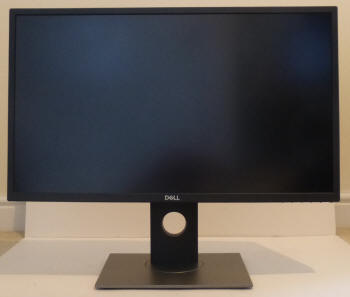
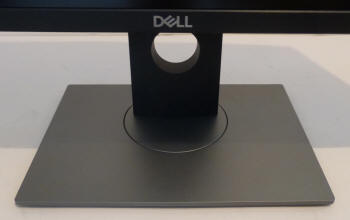
Above: front views of the screen and stand. Click for larger versions
The UP2718Q comes in a black and space grey
design, with matte plastics used for the bezel, stand and base. It has quite a
solid, professional look as opposed to being overly fancy or eye-catching,
fitting in with its target market nicely. The bezel measures ~14mm along the
sides and top with a small additional 1mm black panel border to give a total
15mm edge. Along the bottom of the screen this is slightly thicker at 17mm bezel
+ 1mm panel border. There is a shiny silver Dell logo in the middle of the
bottom bezel but no other logos or writing on the front of the screen. The OSD
and power buttons are tucked underneath the bottom right hand edge of the
display and so are out of sight during normal use from a typical viewing
position. The base of the stand is finished in a dark space grey plastic and
provides a sturdy and strong base for the quite heavy screen. It measures 293 x
200mm.
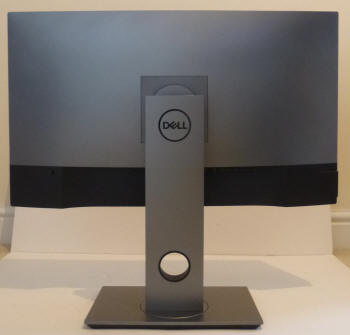
Above: back view of the screen. Click for larger versions
The back of the screen is encased in a space
grey plastic as shown above. The stand attaches easily in to the back of the
screen with a quick-release mechanism, and can be removed for VESA 100 mounting
options if you want. There is a cable tidy hole in the stand as well.
The screen has a fairly thick profile as you
can see from the below images which is a result of the wide gamut GB-r-LED and
384-zone local dimming backlight unit. It isn't overly thick, but certainly more
chunky than the wide range of ultra-thin screens you can find in the market
today.
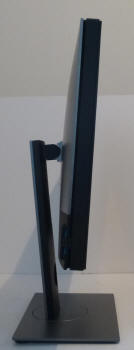
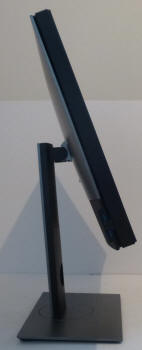
Above: full tilt range shown. Click for larger versions
There is a decent set of ergonomic
adjustments offered from this screen. Tilt is smooth and easy to use and offers
a good range of adjustment as you can see from the above pictures.
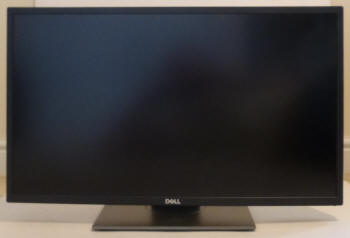
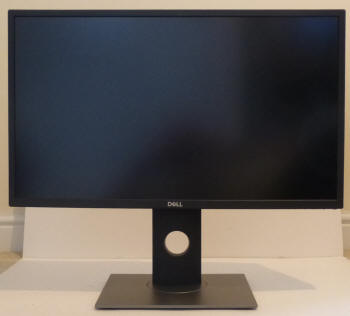
Above: full height adjustment range shown. Click for larger versions
Height
adjustment is a little bit stiff but offers smooth movements as well, with a
total measured adjustment range of 140mm. At the lowest setting the bottom edge of the
screen is ~40mm from the edge of the desk, and at maximum extension is is
~180mm. Side to side swivel is a easy to use and again offers smooth
movements and a wide range. The base of the stand stays firmly positioned on the
desk as you move the screen side to side. Rotation in to portrait mode is a
little bumpy but easy enough to use and might be useful to some users.

A summary of the ergonomic adjustments
are shown below:
|
Function |
Range |
Smoothness |
Ease of Use |
|
Tilt |
Yes |
Smooth |
Easy |
|
Height |
140mm |
Smooth |
A bit stiff |
|
Swivel |
Yes |
Smooth |
Easy |
|
Rotate |
Yes |
Moderate |
A bit stiff |
|
Overall |
Good range of adjustments
and smooth movements, mostly easy to use. No wobble |
The materials were of a good standard and the
build quality felt very good as well. There was no audible noise from the screen,
even when conducting specific tests which can often identify buzzing issues.
The whole screen remained fairly cool even during prolonged use as well which
was pleasing although a bit of heat from the top is common given the bigger
backlight unit and higher power consumption.

Above: connection options on the back of the screen. Click for larger
version
The back of the screen features the
connections. To the left (not pictured here) is the power connection. You only need a normal
kettle lead here as the power supply is built in to the screen. There are then
2x HDMI 2.0a, DisplayPort 1.4, Mini DisplayPort 1.4,
audio out, 2x USB upstream and 2x USB 3.0 downstream connections. One of these
has fast charging support.
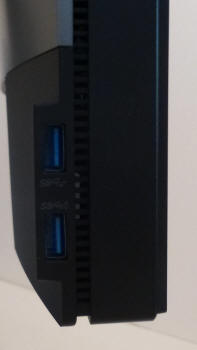
Above: easy access USB ports on left hand side. Click for larger
version
There are also 2 additional USB 3.0 ports
located on the left hand side of the screen for easy access which was nice to
see. One of these has fast charging support.

OSD Menu
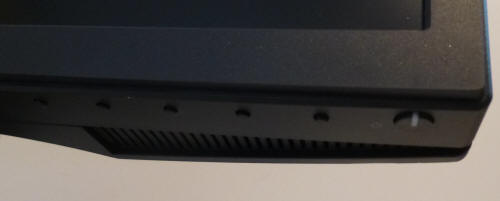
Above: OSD control buttons on the bottom right hand edge of the screen. Click for larger
version
The OSD menu is controlled through 5 small
buttons and a power on/off button located on the bottom underside edge of the
screen, in the right hand corner. They are easy to find and use. The power
button has a very small white LED when the screen is powered on.
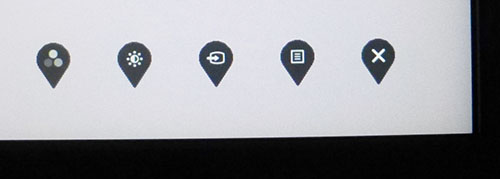
Pressing any of the OSD buttons pops up the
above quick launch menu, which can actually be customised in the main menu if
you want access to other options quickly instead of these defaults. Each quick
launch item is presented on the screen above where the control buttons are,
making it easy to select the required option. By default there is quick launch
access to the preset modes, brightness/contrast controls, input selection and
then the main menu itself.
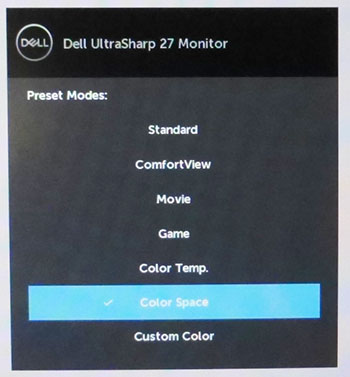
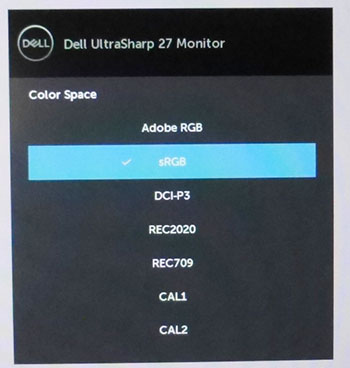
The preset mode menu has loads of different
options to choose from as shown above. Within the 'color space' menu there are
plenty of different options including the Adobe RGB, sRGB and DCI-P3 emulations
modes. You can also switch to the hardware calibrated CAL1 and CAL2 modes if
you've carried out a
hardware calibration of the screen.
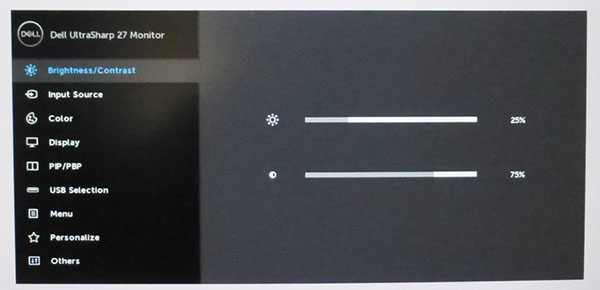
The main menu is split in to 9 sections shown
down the left hand side, with the options available in each presented on the
right.
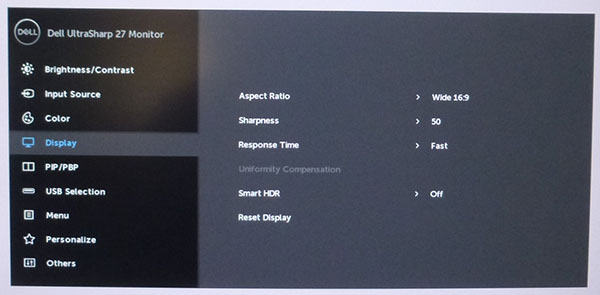
The 'display' section has a few useful
features including the aspect ratio control, response time settings, uniformity
correction (within certain preset modes only) and HDR control.
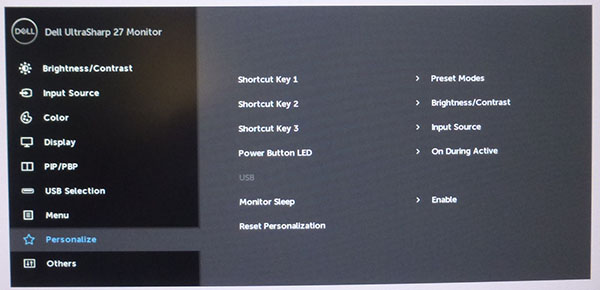
The menu offers a nice wide range of options
and is quick and intuitive to use. We found it easy to navigate, and it will
also remember which section you were last in which can save some time when
playing around with settings.

Power Consumption
In terms of power consumption the
manufacturer lists typical usage of 90W, maximum of 120W (with USB active too) and
<0.5W in standby. We carried out our normal tests to
establish its power consumption ourselves.
|
 |
|
State and Brightness
Setting |
Manufacturer Spec (W) |
Measured Power Usage
(W) |
|
Default (75%) |
90.0 |
66.4 |
|
Calibrated (28%) |
- |
44.3 |
|
Maximum Brightness (100%) |
120.0 |
78.2 |
|
Minimum Brightness (0%) |
- |
31.0 |
|
Standby |
<0.5 |
0.8 |
|
We tested this ourselves and found that out of the
box the screen used 66.4W at the default 75% brightness setting. Once calibrated the screen reached
44.3W consumption, and in standby it
used only 0.6W. We have plotted these results below compared with other screens
we have tested. The calibrated consumption is comparable to the other 27" sized
screens with wide gamut GB-r-LED backlights we have tested like the Dell U2713H
for example. Larger sized screens with wide gamut LED backlights like the Dell
UP3214Q use a little more power, and those with wide gamut CCFL backlights like
the NEC PA271W use even more. The power usage of the UP2718Q is higher than the
wide range of sRGB 27" screens which use W-LED backlighting, as a GB-r-LED
backlight has a higher power consumption.


Panel and Backlighting
|
Panel Manufacturer |
LG.Display |
Colour Palette |
1.07 billion |
|
Panel Technology |
IPS |
Colour Depth |
10-bit |
|
Panel Module |
LM270WR6-SPA1 |
Colour space |
Wide gamut |
|
Backlighting Type |
GB-r-LED |
Colour space coverage (%) |
100%
sRGB, 100% Adobe RGB, 100% Rec.709, 97.7% DCI-P3, 76.9% Rec.2020 |
Panel Part and Colour Depth
The Dell UP2718Q features an
LG.Display LM270WR6-SPA1 IPS technology panel which is capable of producing
1.07 billion colours. This is achieved through a 10-bit colour depth. Keep in
mind whether this 10-bit support is practically useable and whether you're ever
going to truly use that colour depth. You need to have a full 10-bit end
to end workflow to take advantage of it which is still quite expensive to
achieve and rare in the market, certainly for your average user. This includes
relevant applications and graphics cards as well, so to some people this 10-bit
support might be irrelevant. Given this is a high end, professional-grade
screen the 10-bit support is useful and may well be required for some users. It
also allows the screen to meet the strict Ultra HD Premium standards for HDR
which we will talk about more later.
The panel part is confirmed when dismantling
the screen as shown below:

Screen
Coating
The
screen coating is a light anti-glare (AG). Thankfully it
isn't a heavily grainy coating like some old IPS-type panels and is also lighter
than TN Film technology coatings. It retains its anti-glare properties
to avoid too many unwanted reflections of a full glossy coating, but does not
produce an too grainy or dirty an image that some thicker AG coatings can.
There are no visible cross-hatching patterns evident.
Backlight Type and Colour Gamut
The screen uses a GB-r-LED backlight unit
which offers a wide colour gamut, beyond the common sRGB gamut models in the
market. This backlight allows the screen to cover much wider colour gamuts and
the spec confirms that it will offer 100% sRGB coverage (and well beyond), 100%
Adobe RGB, 100% Rec.709, 97.7% DCI-P3 and 76.9% Rec.2020. It is the DCI-P3
colour space which is becoming most commonly talked about when it comes to HDR
displays, as the Ultra HD Premium spec dictates that a HDR display should support this colour space properly. Given
the screen is Ultra HD Premium certified, they must consider 97.7% to be close
enough. The wide range of supported colour spaces, including emulation options
for Adobe RGB, DCI-P3 and sRGB account for various user scenarios and content
requirements. If you want to read more about colour spaces and gamut
then please have a read of our
detailed article.
Backlight
Dimming and Flicker
We tested the screen to establish the methods used
to control backlight dimming. Our in depth article talks in more details about a
previously very common method used for this which is called
Pulse Width Modulation (PWM). This in itself gives cause for concern to some
users who have experienced eye strain, headaches and other symptoms as a result
of the flickering backlight caused by this technology. We use a photosensor +
oscilloscope system to measure backlight dimming control
with a high level of accuracy and ease. These tests allow us to establish
1) Whether PWM is being used to control the
backlight
2) The frequency and other characteristics at which this operates, if it is used
3) Whether a flicker may be introduced or potentially noticeable at certain
settings
If PWM is used for backlight dimming, the higher
the frequency, the less likely you are to see artefacts and flicker. The duty
cycle (the time for which the backlight is on) is also important and the shorter
the duty cycle, the more potential there is that you may see flicker. The other
factor which can influence flicker is the amplitude of the PWM, measuring the
difference in brightness output between the 'on' and 'off' states. Please
remember that not every user would notice a flicker from a backlight using PWM,
but it is something to be wary of. It is also a hard thing to quantify as it is
very subjective when talking about whether a user may or may not experience the
side effects.
100% 50%
0%



Above scale = 1
horizontal grid = 5ms
The backlight control on this screen is a
little unusual. There is no typical PWM pattern on this screen as you dim the
backlight, so it is certainly not being rapidly switched off and on, and so
there should be no visible flicker. As you can see however there is a very low
amplitude oscillation present at all settings, even 100% brightness. This
operates at a high 4000 Hz frequency, and is very low amplitude (i.e. very little
difference in luminance between the upper and lower range) and so it is
extremely unlikely to result in any flicker or eye-related problems.
|
Pulse Width
Modulation Used |
No
(but low amplitude oscillation) |
|
Cycling
Frequency |
n/a (4000Hz low amplitude
oscillation) |
|
Possible
Flicker at |
|
|
100% Brightness |
Very unlikely |
|
50% Brightness |
Very unlikely |
|
0% Brightness |
Very unlikely |

Contrast
Stability and Brightness
We wanted to see how much variance there was in
the screens contrast as we adjusted the monitor setting for brightness.
In theory, brightness and contrast are two independent parameters, and good
contrast is a requirement regardless of the brightness adjustment.
Unfortunately, such is not always the case in practice. We recorded the
screens luminance and black depth at various OSD brightness settings, and
calculated the contrast ratio from there. Graphics card settings were left at
default with no ICC profile or calibration active. Tests were made using an
X-rite i1 Display Pro colorimeter. It should be noted that we used the
BasICColor calibration software here to record these, and so luminance at
default settings may vary a little from the LaCie Blue Eye Pro report.
|
OSD
Brightness |
Luminance
(cd/m2) |
Black
Point (cd/m2) |
Contrast
Ratio
( x:1) |
|
100 |
349.26 |
0.34 |
1027 |
|
90 |
321.64 |
0.31 |
1038 |
|
80 |
293.98 |
0.28 |
1050 |
|
70 |
252.35 |
0.24 |
1051 |
|
60 |
224.60 |
0.21 |
1070 |
|
50 |
196.77 |
0.19 |
1036 |
|
40 |
154.77 |
0.15 |
1032 |
|
30 |
126.98 |
0.12 |
1058 |
|
20 |
99.30 |
0.09 |
1103 |
|
10 |
57.89 |
0.06 |
965 |
|
0 |
31.43 |
0.03 |
1048 |
|
Total Luminance Adjustment Range
(cd/m2) |
317.83 |
Brightness OSD setting controls backlight? |
 |
|
Total Black Point
Adjustment Range (cd/m2) |
0.31 |
|
Average Static Contrast Ratio |
1043:1 |
PWM Free? |
 |
|
Recommended OSD setting
for 120 cd/m2 |
28 - 29 |
The brightness control gave us a good range
of adjustment. At the top end the maximum luminance reached 349
cd/m2
which was a bit lower than the specified maximum typical brightness of 400 cd/m2
from the manufacturer. Remember that the 1000 cd/m2
peak brightness figure in the spec is relevant when using the HDR feature which we will
look
at later on. With HDR mode turned off, you are operating within the brightness
range shown above.
There was a very good
318 cd/m2 adjustment range in total, and so at the minimum setting
you could reach down to a low luminance of 31 cd/m2. This should be adequate for those wanting to
work in darkened room conditions with low ambient light. A setting of 28 - 29 in the OSD menu should return you a
luminance of around 120 cd/m2 at default settings. This was a little
fiddly as there seemed to be a bit of a jump in luminance from 28 (113 cd/m2)
to 29 (127 cd/m2).
It should be noted that the
brightness regulation is controlled without the need for
Pulse Width Modulation, using a Direct Current (DC) method for all
brightness settings between 100 and 0%. There is a very low amplitude and high
frequency oscillation at all brightness settings but the screen can still be
classified as flicker free.

We have plotted the
luminance trend on the graph above. The screen behaves as it should in this
regard, with a reduction in the luminance output of the screen controlled by the
reduction in the OSD brightness setting. This is mostly a linear relationship as you
can see although there seemed to be some slight steps at certain points.

The average contrast ratio of the screen
was good for an IPS panel at 1043:1. This was stable across the brightness
adjustment range on the most part, although there did seem to be a bit of
variation for the
very low end of the brightness adjustment range. Remember, the 20,000:1 contrast
ratio figure in the spec relates to the HDR operation of the screen which we
will talk about more later on.

Testing
Methodology
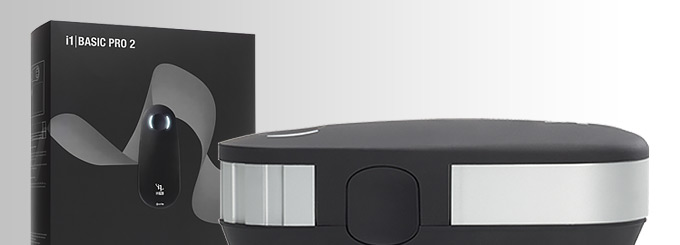
An
important thing to consider for most users is how a screen will perform out of
the box and with some basic manual adjustments. Since most users won't have
access to hardware colorimeter tools, it is important to understand how the
screen is going to perform in terms of colour accuracy for the average user.
We restored our graphics card to default settings
and disabled any previously active ICC profiles and gamma corrections. The
screen was tested at default factory settings using our new
X-rite i1
Pro 2 Spectrophotometer combined with
LaCie's Blue Eye Pro software suite. An X-rite i1 Display Pro colorimeter was
also used to verify the black point and contrast ratio since the i1 Pro 2
spectrophotometer is less
reliable at the darker end.
Targets for these tests are as follows:
-
CIE Diagram - validates the colour space
covered by the monitors backlighting in a 2D view, with the black triangle representing the
displays gamut, and other reference colour spaces shown for comparison
-
Gamma - we aim for 2.2 which is the default
for computer monitors
-
Colour temperature / white point - we aim
for 6500k which is the temperature of daylight
-
Luminance - we aim for 120
cd/m2, which is
the recommended luminance for LCD monitors in normal lighting conditions
-
Black depth - we aim
for as low as possible to maximise shadow detail and to offer us the best
contrast ratio
-
Contrast ratio - we aim
for as high as possible. Any dynamic contrast ratio controls are turned off here
if present
-
dE average / maximum -
as low as possible.
If DeltaE >3, the color displayed is significantly different from the
theoretical one, meaning that the difference will be perceptible to the
viewer.
If DeltaE <2, LaCie considers the calibration a success; there remains a
slight difference, but it is barely undetectable.
If DeltaE < 1, the color fidelity is excellent.

Default Performance and
Setup
Each UP2718Q monitor is factory calibrated in
the Adobe RGB and sRGB preset modes. This is designed to deliver a Delta E < 2,
an accurate gamma curve, specific grey-scale tracking (colour temp) and
brightness uniformity. You can access the two factory calibrated modes by
switching to the Adobe RGB or sRGB 'color space' modes. If you want the
uniformity calibration as well, you will need to additionally turn on
'uniformity compensation' from within the OSD menu.
We have provided a copy of the
calibration report for our unit which comes in the box with the screen, for
those interested:
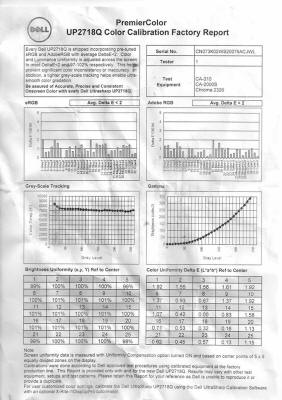
By default the screen is actually set in the 'standard'
preset mode which
does not carry any specific factory calibration. We will test that
out-of-the-box setup first of all here.
Default settings of the screen were as follows:
|
Monitor OSD Option |
Default Settings |
|
Preset mode |
Standard |
|
Brightness |
75 |
|
Contrast |
75 |
|
Uniformity Compensation |
Off |
|
RGB |
n/a |

Dell UP2718Q
- Default Settings (not factory calibrated)



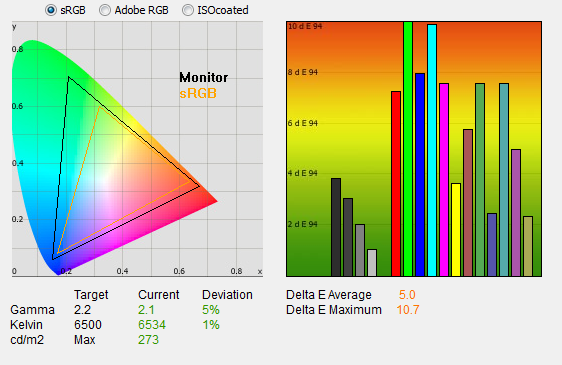

|
|
Default Settings
Standard mode |
|
luminance (cd/m2) |
273 |
|
Black Point (cd/m2) |
0.27 |
|
Contrast Ratio |
1019:1 |
Initially out of the box the screen was set
with a high 75% brightness and so was overly bright and uncomfortable to use, so you will
definitely need to turn that down. You could tell the screen was using a wide
gamut backlight as colours looked more vivid and saturated than common sRGB-only
screens. This standard preset mode uses the full native gamut of the backlight
without any restrictions.
We went
ahead and measured the default state with the i1 Pro 2. The
CIE diagram
on the left of the image confirms that the monitors colour gamut (black
triangle) extends far beyond the typical sRGB space. There is much wider
coverage in green shades most notably, leading to more saturated and somewhat
neon looking green shades in practice.
Default gamma was recorded at 2.1 average, leaving it with a minor 5% deviance
from the target which was pretty good. There are no gamma modes available in the
OSD menu, so this will be difficult to correct without a calibration device.
Given this is a very expensive high end, professional grade screens, we expect
you will almost certainly have a calibration device anyway, and probably want to
take advantage of the hardware calibration function offered on this model as
well. White
point was measured at a very accurate 6534k in the default preset, leaving only
a very minor 1% deviance.
Luminance was recorded at a very bright 273
cd/m2 which is
too high for prolonged general use. The screen was set at a default 75%
brightness in the OSD menu but that is easy to change of course to reach a more
comfortable setting without impacting any other aspect of the setup. The black
depth was 0.27 cd/m2 at this default
brightness setting, giving us a good static contrast ratio for an IPS-type panel of
1019:1.
Colour accuracy was hard to measure in this
default mode because of the wide gamut backlight, and the fact that colours are
being compared against an sRGB reference. So they are "inaccurate" if compared
with sRGB colours, with a dE of 5.0 average, but that is to be expected when a
wide gamut colour space is being output. Testing the sRGB emulation preset mode
in a moment will hopefully give us a better view. Testing the screen with colour
gradients showed smooth gradients with only very minor gradation evident in darker
tones. There was no sign of any colour banding which was good news.

We went ahead and measured the Adobe RGB factory calibrated mode as well:
|
Monitor OSD Option |
Default Settings |
|
Preset mode |
Color Space > Adobe RGB |
|
Brightness |
75 |
|
Contrast |
75 |
|
Uniformity Compensation |
Off |
|
RGB |
n/a |

Dell UP2718Q
- Default Settings (Adobe RGB factory calibrated mode)
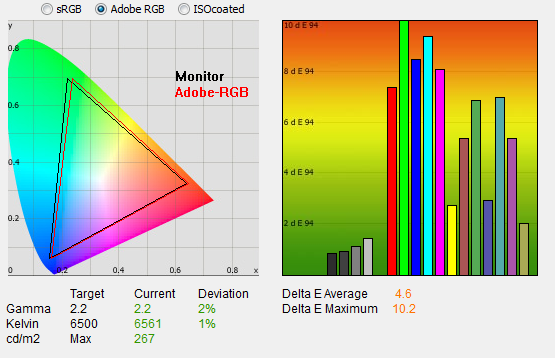

|
|
Default Settings
Adobe RGB mode |
|
luminance (cd/m2) |
267 |
|
Black Point (cd/m2) |
0.27 |
|
Contrast Ratio |
996:1 |
We changed to the Adobe RGB 'color space'
preset mode which carries the factory calibration. The gamma was slightly more
accurate now at 2.2 average, with only a 2% deviance. White point remained
consistent at 6561k (1% deviance). Brightness was still too high, but contrast
ratio remained decent enough for an IPS panel at 996:1. Of interest
is if we compare the colour gamut in this mode:
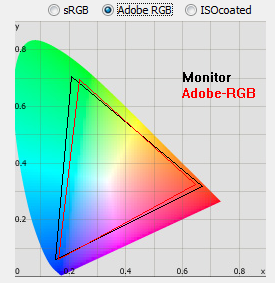
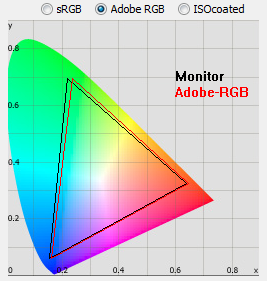
Adobe RGB gamut coverage in Standard
preset mode (left) vs Adobe RGB preset mode (right)
You can see above a comparison of the
monitors gamut (represented by the black triangle) against the Adobe RGB
reference space (red triangle). These measurements were taken in the default
'standard' preset mode, and then the specific Adobe RGB colour space mode. You
will see that the specific Adobe RGB mode emulates the colour space slightly
more closely, cutting down a little in some of the over-coverage in green
shades. It's not a massive amount, since the native gamut of the backlight is
already very close to the Adobe RGB space, but a little bit of emulation is
going on here still.
Again, it's hard to comment on the dE figures
in this mode, since they are comparing colours produced against an sRGB reference, but
the rest of the factory setup seemed reliable.

We went ahead and measured the sRGB factory calibrated mode as well:
|
Monitor OSD Option |
Default Settings |
|
Preset mode |
Color space > sRGB |
|
Brightness |
75 |
|
Contrast |
75 |
|
Uniformity Compensation |
Off |
|
RGB |
n/a |

Dell UP2718Q
- Default Settings (sRGB factory calibrated mode)


|
|
Default Settings
sRGB mode |
|
luminance (cd/m2) |
268 |
|
Black Point (cd/m2) |
0.27 |
|
Contrast Ratio |
999:1 |
You can see here that the colour space now very closely matches the
sRGB reference, and it is emulated nicely. An additional measurement with
ChromaPure 3 measured a 100.7% sRGB coverage in this emulation node. Note that
this specific sRGB coverage corresponds to 74.2% of the DCI-P3 colour space and
53.2% of the very large Rec.2020 space.
Gamma and white point remain very
close to their targets with only a small 2% deviance on each. We can get a much
better view of dE accuracy here now that we are comparing an sRGB colour output with an sRGB
reference. It was measured at an excellent 1.1 dE average and this gave us a
very good factory calibration in this colour space. It's very useful to have an
sRGB mode for those who want to work with sRGB content more closely, and don't
want the wide gamut colour space of the backlight for some uses. That will avoid
any complications with colour management if you want to work with or view the
wide range of sRGB-based content out there.

Calibration
(Software Profiling)
We used the
X-rite i1 Pro 2
Spectrophotometer combined with the LaCie Blue Eye Pro software package to
achieve these results and reports. An X-rite i1 Display Pro colorimeter was used
to validate the black depth and contrast ratios due to lower end limitations of
the i1 Pro device.
|
Monitor OSD Option |
Calibrated Settings |
|
Preset mode |
Custom Color |
|
Brightness |
28 |
|
Contrast |
75 |
|
Uniformity Compensation |
Off |
|
RGB |
98, 90, 99 |

Dell UP2718Q
- Calibrated Settings (Software Profiling)
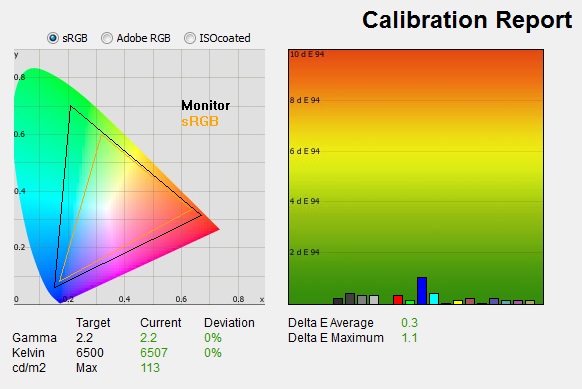

|
|
Calibrated Settings |
|
luminance (cd/m2) |
113 |
|
Black Point (cd/m2) |
0.115 |
|
Contrast Ratio |
980:1 |
We changed to the 'custom color' preset
mode which
offered us access to the RGB controls from within the menu. We adjusted the RGB
channels and brightness setting as shown in the table above as part of the
guided calibration process. These OSD
changes allowed us to obtain an optimal hardware starting point and setup before software level changes would be
made at the graphics card level. We left the LaCie software to calibrate
to "max" brightness which would just retain the luminance of whatever brightness
we'd set the screen to, and would not in any way try and alter the luminance at
the graphics card level, which can reduce contrast ratio. These adjustments
before profiling the screen would help preserve tonal values and limit
banding issues. After this we let the software carry out the LUT adjustments and create an
ICC profile.
In this 'custom color' mode, you are left
with the native (full) gamut of the backlight, but we know that there is already
a very accurate sRGB emulation mode and factory calibrated state if you want to
work with the smaller sRGB gamut anyway.
Average gamma was now corrected to 2.2
average a 0% deviance, correcting the 5% deviance we'd seen out of the box in
the 'standard' preset mode. The
white point had now been corrected to 6470k, which corrected the very minor 1% deviance
we'd seen out of the box. Luminance had been improved thanks to the adjustment
to the brightness control and was now being measured at 113
cd/m2. The
next 1% up in the brightness control bumped us up to 127 cd/m2 so we
stuck with a setting of 28% which was a little low. This left us a black depth of 0.115 cd/m2 and maintained a strong IPS static
contrast ratio of
980:1. Colour accuracy of the resulting
profile was excellent, with dE average of 0.3 and maximum of 1.1. LaCie would
consider colour fidelity to be very good.
Testing the screen with various colour gradients
showed very smooth transitions with no banding evident at all.
You can use our settings and
try our calibrated ICC profile if you wish, which are available in
our ICC profile database. Keep in mind that results will vary from one
screen to another and from one computer / graphics card to another.

Hardware Calibration
The UP2718Q is part of Dell's UltraSharp
Premium range of screens and features hardware calibration support. You are able
to calibrate the screen at the monitor LUT (Look Up Table) level, to store
calibrated settings in the screen itself. This provides users with a more
advanced and better level of control over the settings of the screen, and means
you don't have to rely on graphics card level profiles. Particularly useful to
avoid any complications with colour managed workflows and to maintain settings
in all applications, where perhaps ICC profile support might sometimes be
difficult or absent.
Dell provide their own 'UltraSharp
Calibration' software package, powered by X-rite. It is compatible with X-rites
i1 Display Pro colorimeter, and i1 Pro / i1 Pro 2 spectrophotometers which can
be purchased separately. We looked at Dell's calibration software
back in October 2014 when we reviewed the UP3214Q display, but have provided
some updated screenshots and notes below while we test the latest version
(v1.6.1) on the UP2718Q display.
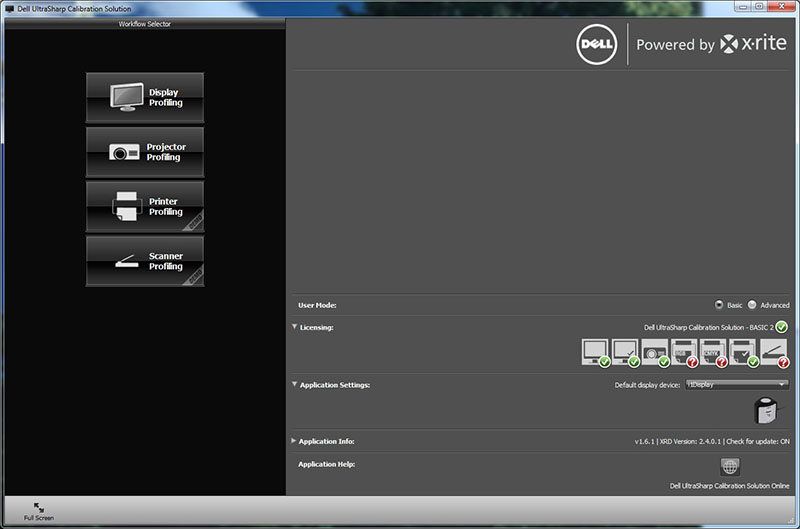
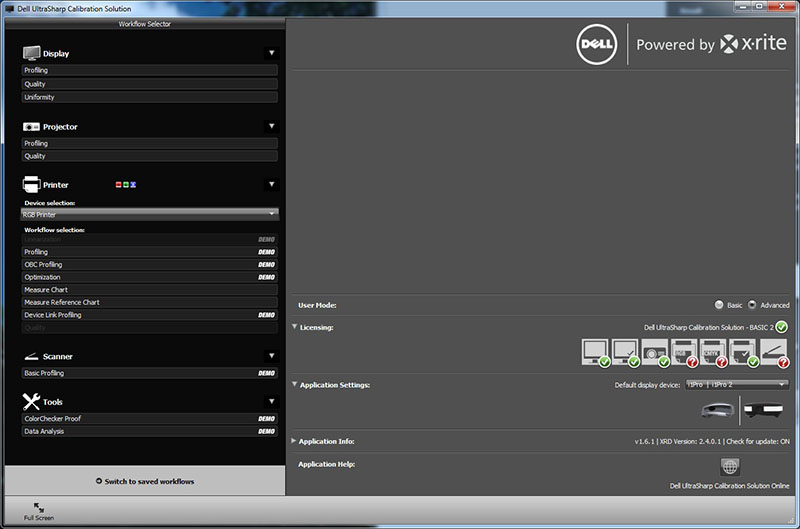
Loading up the software you are presented
with the above home screen. Once a valid device is plugged in, it is verified on
the right with the green ticks. You can move from the basic mode (top image) to the advanced mode
(bottom image) if you want
more options and settings to change.
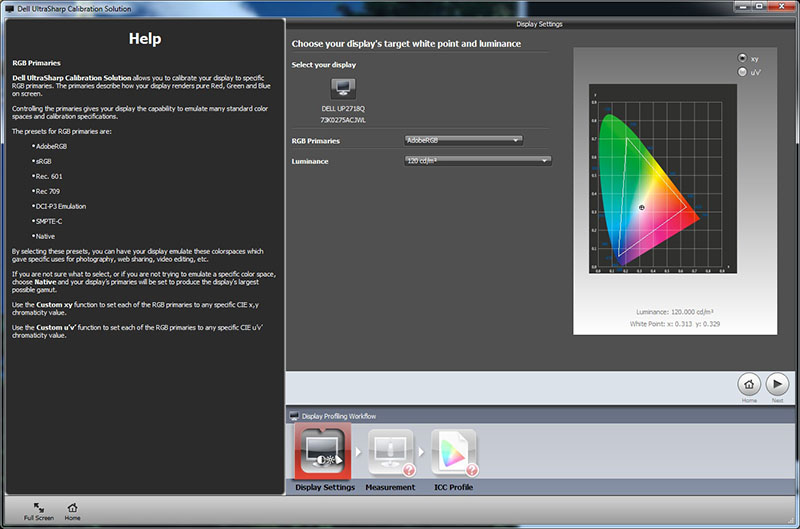
We followed through the 'display profiling'
process to calibrate the screen. You are first of all asked to select your
desired colour space and luminance target. It's possible to calibrate to loads
of different defined colour spaces including Adobe RGB, sRGB, DCI-P3, etc and
there is a lot of flexibility to choose your own target range if you need to.
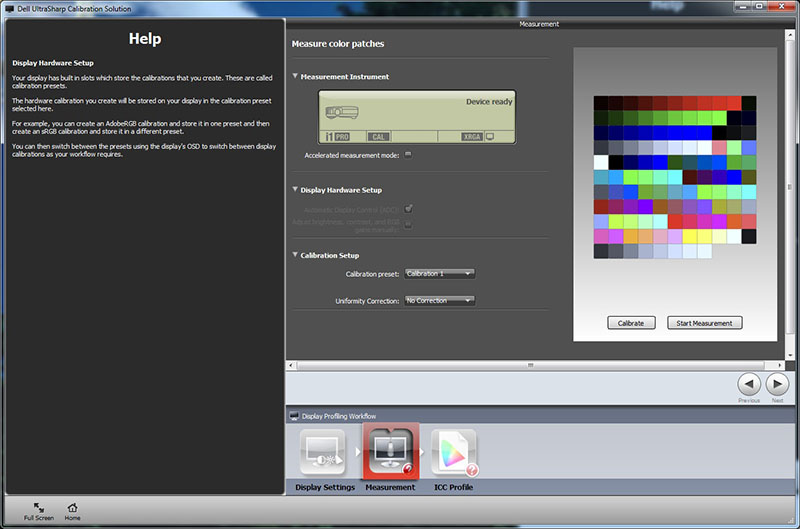
You are then asked to select which hardware
calibration mode you are going to be configuring. There are two options on the
UP2718Q that you can hardware calibrate, modes CAL1 and CAL2. If you want to,
you can also turn on uniformity correction here which will add an additional
stage to the process, allowing you to set up uniformity correction at the same
time as the calibration.
From there, you start the measurement and
calibration process. It is entirely automated so you don't have to do anything,
but it takes a very long time to complete. With our i1 Pro 2 spectrophotometer,
and even with the smallest (and therefore quickest) sample set of 118 in the
settings for the software, the calibration process took about 45 minutes. Once
set up though and saved to the monitor LUT, you can easily switch away from the
CAL mode to one of the other presets, knowing that you can easily switch back to
your calibrated state when you need. With two CAL modes available you can set up
to a couple of different colour spaces or different targets if you want (e.g.
DCI-P3 and sRGB).
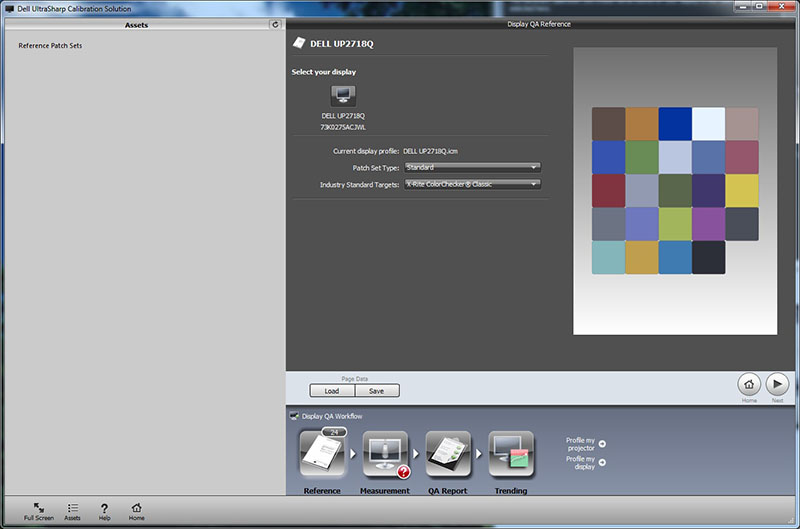
At the end you can go back to the home screen
and if you enter the 'advanced' mode, you can run a few quality checking
options.
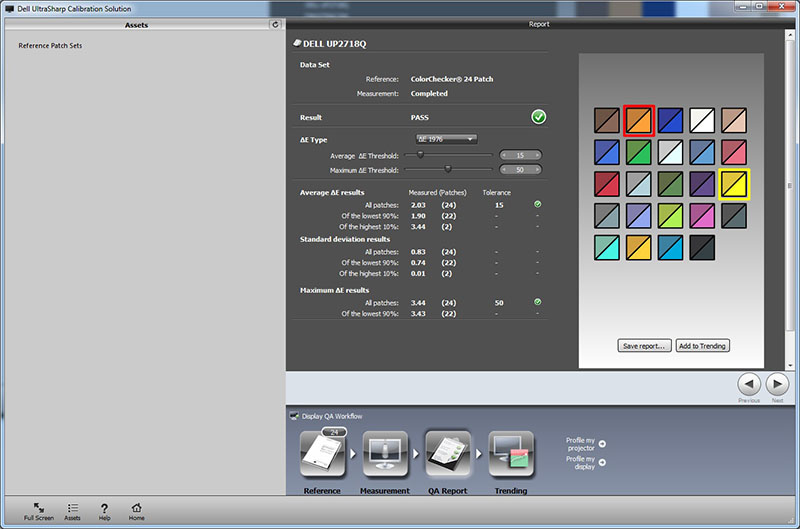
These are fairly basic quality checks, giving
you some results like those shown above.
We also used our i1 Pro 2 spectrophotometer
to validate the results using the familiar LaCie Blue Eye Pro software:

Dell UP2718Q
- Hardware Calibration
Adobe RGB Colour Space Target
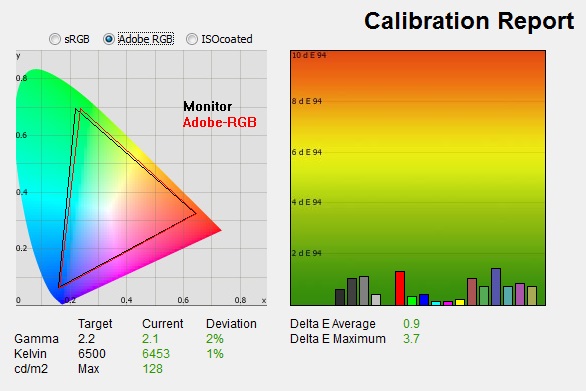
|
|
Hardware
Calibrated Settings, Adobe RGB |
|
luminance (cd/m2) |
128 |
|
Black Point (cd/m2) |
0.11 |
|
Contrast Ratio |
1171:1 |
The above validation step confirms some very good
results from the hardware calibration process. Keep in mind there is likely to
be some slight variance in the two software packages. Nevertheless it confirms a solid result from the hardware
calibration with only minor deviance in gamma and white point. Luminance was
a little too high but we had achieved now a stronger static contrast ratio of
1171:1 which was pleasing.

Calibration Performance Comparisons

The comparisons made in this section try to give
you a better view of how each screen performs, particularly out of the box which
is what is going to matter to most consumers. When comparing the default factory
settings for each monitor it is important to take into account several
measurement areas - gamma, white point and colour accuracy. There's no point
having a low dE colour accuracy figure if the gamma curve is way off for
instance. A good factory calibration requires all 3 to be well set up. We have
deliberately not included luminance in this comparison since this is normally
far too high by default on every screen. However, that is very easily controlled
through the brightness setting (on most screens) and should not impact the other
areas being measured anyway. It is easy enough to obtain a suitable luminance
for your working conditions and individual preferences, but a reliable factory
setup in gamma, white point and colour accuracy is important and not as easy to
change accurately without a calibration tool.
From these comparisons we can also compare the
calibrated colour accuracy, black depth and contrast ratio. After a calibration
the gamma, white point and luminance should all be at their desired targets.
Default setup of the screen out of the box was
good even in the standard preset which did not carry a factory calibration.
Gamma was a little out (5% deviance) but white point was close to the target. We
will ignore the default dE figure here since the standard mode operates with the
full native gamut of the backlight and dE is being compared against a smaller
sRGB colour space in the validation test. You can achieve nice reliable out of
the box setup in the Adobe RGB and sRGB
modes as well which carry the factory calibration. Of course being a
professional grade screen you are almost certainly going to want to calibrate
the screen, preferably at the monitor hardware LUT level, which gives you a huge
amount of control and high levels of accuracy.


The display was good when it came to static
contrast ratio for an IPS panel at 980:1. Anything around 1000:1 is decent for
this panel technology and it was on par with some other IPS screens shown here.
Some modern IPS panels can reach up closer to 1200:1, and VA panels (not shown
here) can of course reach higher up to over 3000:1. We will
test HDR later on
which will deliver different contrast ratios.
|
Check Pricing and Buy - Direct Links
|
|
Amazon
|
|
TFTCentral is a participant
in the Amazon Services LLC Associates Programme, an affiliate
advertising programme designed to provide a means for sites to earn
advertising fees by advertising and linking to Amazon.com, Amazon.co.uk,
Amazon.de, Amazon.ca and other Amazon stores worldwide. We also
participate in a similar scheme for Overclockers.co.uk. |

Viewing Angles

Above: Viewing
angles shown from front and side, and from above and below. Click for
larger image
Viewing angles of the screen were very good
as you would expect from an IPS panel. Horizontally there was very little colour
tone shift until wide angles past about 45°. A slight darkening of the image
occurred horizontally from wider angles as you can see above as the contrast
shifted slighting. A pink colour tint was also introduced from wider angles. Contrast shifts
and the pink colour tone were slightly more noticeable in the vertical
field but overall they were still good. The screen offered the wide viewing
angles of IPS technology and was free from the restrictive fields of view of TN
Film panels, especially in the vertical plane. It was also free of the
off-centre contrast shift you see from VA panels and a lot of the quite obvious
gamma and colour tone shift you see from some of the modern VA panel type
offerings. IPS is the preferred technology for colour critical work and
professional applications, so it was pleasing to see that panel technology
utilised on this display.
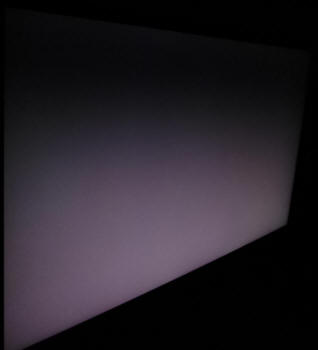
Above: View of an
all black screen from the side. Click for larger version
On a black image there is a characteristic
white glow when viewed from an angle, commonly referred to as "IPS-glow". This
is common on most modern IPS-type panels and can be distracting to some users.
The level of glow here is the same as other recent IPS panels we've seen and is
pretty typical of a modern IPS-type panel. If you view dark content from a
normal head-on viewing position, you can actually see this glow slightly as your
eyes look towards the edges of the screen. Some people may find this problematic
if they are working with a lot of dark content or solid colour patterns. In
normal day to day uses, office work, movies and games you couldn't really notice
this unless you were viewing darker content. If you move your viewing position
back, which is probably likely for movies and games, the effect reduces as you
do not have such an angle from your eye position to the screen edges.

Panel Uniformity
We wanted to test
here how uniform the brightness was across the screen, as well as identify any
leakage from the backlight in dark lighting conditions. Measurements of the
luminance were taken at 35 points across the panel on a pure white background.
The measurements for luminance were taken using BasICColor's calibration
software package, combined with an X-rite i1 Display Pro colorimeter with a
central point on the screen calibrated to 120 cd/m2. The below
uniformity diagram shows the difference, as a percentage, between the
measurement recorded at each point on the screen, as compared with the central
reference point.
It is worth
noting that panel uniformity can vary from one screen to another, and can depend
on manufacturing lines, screen transport and other local factors. This is only a
guide of the uniformity of the sample screen we have for review.

The UP2718Q features a uniformity
correction feature which is sometimes available on professional grade
screens. On this model it is available within the 'display' section of the
menu and has options for 'off' and 'calibrated'. It is only possible to turn this
feature on in certain preset modes as well - standard, custom color, color
temp. You cannot use it in ComfortView, Movie, Game or any of the color
space modes unfortunately. If you hardware calibrate the screen there is an
option to include uniformity correction calibration during that process.

Uniformity of Luminance - Correction
OFF
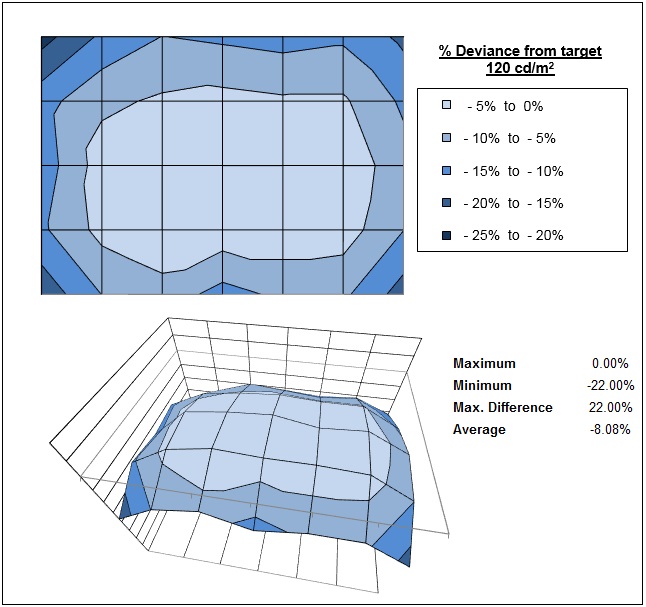
First of all we tested the screen with
uniformity correction turned OFF, in the 'custom color' preset mode (after
calibration) with a centrally calibrated luminance of 120
cd/m2.
The screen showed some drop off in luminance around the edges, where it went
down as low as 100 cd/m2 in the most extreme cases (top left
corner). Overall around 70% of the screen was within a 10% deviance from the
centrally calibrated point which was pretty good.

Uniformity of Luminance - Correction
ON
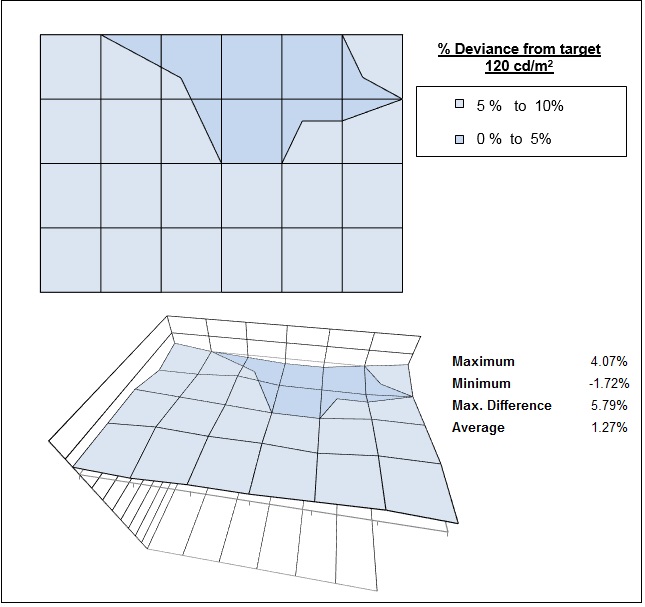
We then tested the screen again with
uniformity correction turned on. We had to increase the brightness control
in the OSD up to 42% to achieve a centrally calibrated luminance of around
120
cd/m2
since the uniformity correction feature is making digital white level
corrections, and so has an impact on the luminance output of the panel.
Thankfully you are able to change the brightness control up and down to suit
when the uniformity correction feature is turned on. Sometimes settings like
that can be locked with these kind of features, but it's nice to see some
flexibility available here. With it turned on, the panel uniformity was
improved very nicely and was excellent. There was a maximum difference
between any two points on the screen of only 5.79% which was great. The
correction worked very well indeed. It should be noted that with this
feature turned on you do lose some contrast, and we measured a static
contrast ratio now of 657:1, compared with the calibrated 980:1 with it
turned off. Some screens will drop contrast even further, so this wasn't too
bad to be honest.

Backlight Leakage
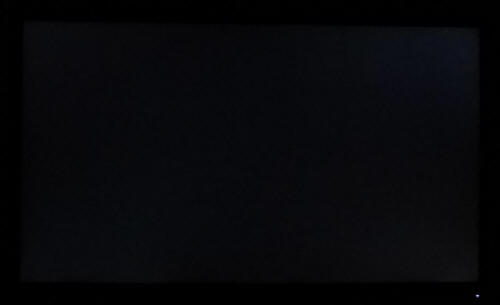
Above: All black screen in a darkened room. Click for larger version
We also tested the screen with an all black image
and in a darkened room. A camera was used to capture the result. The camera
showed there was some slight clouding evident in the right hand corners, but it
was not very noticeable. If you are in a very dark room working with dark content you
may notice this a little, although in day to day use you would be hard pressed
to see any issue.
Note: if you want to test your own screen for
backlight bleed and uniformity problems at any point you need to ensure you have
suitable testing conditions. Set the monitor to a sensible day to day brightness
level, preferably as close to 120
cd/m2 as you can get it (our tests are
once the screen is calibrated to this luminance). Don't just take a photo at the
default brightness which is almost always far too high and not a realistic usage
condition. You need to take the photo from about 1.5 - 2m back to avoid
capturing viewing angle characteristics, especially on IPS-type panels where
off-angle glow can come in to play easily. Photos should be taken in a darkened
room at a shutter speed which captures what you see reliably and doesn't
over-expose the image. A shutter speed of 1/8 second will probably be suitable
for this.

General and Office Applications
The UP2718Q feature a 3840 x 2160 Ultra HD
resolution, all packed in to a 27" sized screen. The higher resolution is not
about providing more screen real-estate here and we need to move away from
thinking about LCD resolution in that manner. In fact it is arguable that the
wide range of 2560 x 1440 resolution panels in the 27" sector are about as high
a resolution as you want to go, without making fonts and icons too small
natively. That provides a pretty comfortable option to work with day to day.
Here, with the resolution being so much
higher it is about providing a sharper and crisper image, while still operating
with a similar desktop area and similar font size to the 1440p models. It is
providing a higher pixel density (Pixels Per Inch, PPI) to improve the degree of
definition to the image. You need to us operating system scaling to handle this
properly. If you try and run the screen without any scaling at 3840 x 2160 the
0.156mm pixel pitch makes everything far too small and tiny. In our view you
need a screen of about 39 - 40" in size (like the
Philips BDM4065UC for example) to use an Ultra HD or 4K resolution
effectively without OS scaling. On this 27" model, if you increase the scaling
to 150%, you actually end up with the same workspace area as 2560 x 1440, but at
a much higher PPI pixel density - and therefore a sharper image. Have a read of
Eizo's very useful article for some more information on the whole matter.
For those wanting a high pixel density for CAD, design, photo work etc, this is
a really good option. The image was very sharp and crisp and text was very
clear. It is a little debatable whether you will gain much benefit from the
higher PPI on a screen this size compared with a 2560 x 1440 standard model, but
some may notice picture quality and sharpness improvements.
Keep in mind that not all Operating Systems
and applications handle scaling the same. More recent versions of Windows (8.1
and 10) tend to handle it all better, and recent versions of Mac OS are pretty
solid as well. Some applications and games don't handle scaling correctly and so
you can end up with some things with very minute text and fonts and some things
which don't scale completely in every place. Keep this in mind if you're
selecting any super high resolution display as it could be an important factor.
You need to ensure you have the necessary operating system and applications to
handle scaling effectively for your needs.
You do need to keep in mind the need for a
compatible graphics card with a suitable output which can handle this
resolution, and at 60Hz refresh rate. DisplayPort and HDMI 2.0 are the only
options to run the screen at its native 3840 x 2160 res at 60Hz, both of which
are supported here. When running at native resolution this model is recognised
as a single display which makes life easier than some of the early MultiStream (MST)
models. It's also good to see support for 60Hz refresh rate as some 4k models
only offer 30Hz support which is very limiting, even in day to day uses
(certainly for gaming!)
The light AG coating of the panel is welcome,
and much better than the grainy and 'dirty' appearance of older IPS AG coatings.
The wide
viewing angles provided by this panel technology on both horizontal and vertical
planes, helps minimize on-screen colour shift when viewed from different angles.
The default setup of the screen was decent as
well, offering an accurate gamma curve, accurate white point and decent contrast
ratio for an IPS panel. There are two factory calibrated modes as well which are
well configured, including options for emulating various colour spaces if you
don't want to work with wide gamut. The sRGB mode is particularly useful given
the widespread use of that colour space, and the sRGB preset comes with a very
good factory calibration. Obviously the wide gamut support gives you the
flexibility to work with wide gamut content where necessary, and the 10-bit
colour depth support is also there if you have a 10-bit graphics card and
workflow. The screen also supports hardware calibration for high levels of
control and accuracy, and the uniformity correction function works very well if
you need to ensure ultra-reliable luminance uniformity for any colour critical
work.
The
brightness range of the screen was also very good, with the ability to offer a
luminance between 349 and 31 cd/m2. This should mean the screen is
perfectly useable in a wide variety of ambient light conditions, including
darkened rooms. A setting of 28 - 29 in the OSD brightness control should return
you a luminance close to 120 cd/m2 out of the box. On another
positive note, the brightness regulation is controlled without the need for the
use of the now infamous
Pulse-Width Modulation (PWM), and so those who suffer from eye fatigue or
headaches associated with flickering backlights need not worry. There was no
audible noise or buzzing from the screen, even when specifically looking for it
using test images with a large amount of text at once. The screen also remains
fairly cool even during prolonged use.
The screen offers 4x USB 3.0 ports (2 with
charging capabilities also) which is very handy. 2 are on the left hand edge of
the screen for easy access. There aren't any other extras like card readers or
ambient light sensors offered though which can be useful in office environments. The stand offers a wide range of
adjustments which is great news, allowing you to obtain comfortable viewing
positions easily.

Responsiveness and Gaming
|
Quoted G2G Response Time |
6ms G2G (fast), 8ms G2G
(normal) |
|
Quoted ISO Response Time |
n/a |
|
Panel Manufacturer and
Technology |
LG.Display IPS |
|
Panel Part |
LM270WR6-SPA1 |
|
Overdrive Used |
Yes |
|
Overdrive Control Available to
User |
Response Time |
|
Overdrive Settings |
Normal, Fast |
The UP2718Q is rated by Dell as having a
6ms G2G response time. The screen uses
overdrive /
response time compensation (RTC) technology to boost pixel transitions
across grey to grey changes with a setting available to the user in the menu to
switch between 'normal' and 'fast' modes. The
part
being used is the
LG.Display LM270WR6-SPA1 IPS technology panel. Have a read about response time in
our
specs section if you need additional information about this measurement.
We will first test the screen using our thorough
response time testing method. This uses an oscilloscope and photosensor to
measure the pixel response times across a series of different transitions, in
the full range from 0 (black) to 255 (white). This will give us a realistic view
of how the monitor performs in real life, as opposed to being reliant only on a
manufacturers spec. We can work out the response times for changing between many
different shades, calculate the maximum, minimum and average grey
to grey (G2G) response times, and provide an evaluation of any overshoot present
on the monitor.
We use an
ETC M526
oscilloscope for these measurements along with a custom photosensor device.
Have a read of
our response time measurement article for a full explanation of the testing methodology and reported
data.
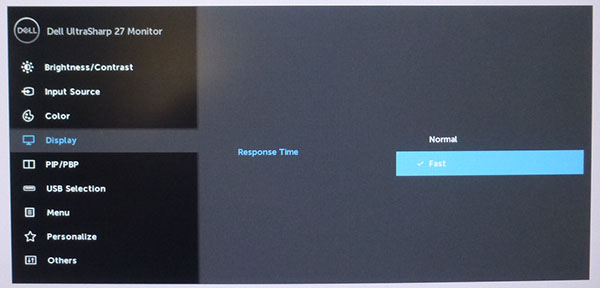
The 'Response Time' setting is available via the
'Display' section of the OSD menu as shown above. We will test the two available modes to see which is optimal. Keep in mind that this screen is not really aimed at gamers, as it
is more of a professional range screen. It has a 60Hz maximum refresh rate as
well.


In the 'normal' mode the average response
time was measured at 13ms G2G. Some transitions were particularly slow,
especially those changing from the darkest shades to light shades (e.g. 0 > 150
or 0 > 255). There was no overshoot in this mode at all, but response times were
fairly slow. They'd be fine for general day to day use of course, but gamers
will see some fairly noticeable blurring to moving images in this mode.
Switching up to the 'fast' mode brought about
some small positive changes. The average response time had improved to 9.9ms G2G
but it was still relatively slow for an IPS-type panel at 60Hz. The better 60Hz
IPS models out there can reach down to around 8.5ms G2G without any overshoot,
so the UP2718Q fell behind a little. It wasn't terrible or anything, but it
certainly can't keep up with modern high-refresh rate IPS panels. They offer
faster response times (in the region of 5ms G2G) along with significantly
increased refresh rates (e.g. 144Hz) and much better motion clarity as a result.
Additional technologies like FreeSync, G-sync and various motion blur reducing
backlights will add an additional positive experience to gaming as well from
other gamer-orientated options.

The above images give you an indication of
the blurring and overshoot levels in each of the Response Time overdrive modes, using the PixPerAn test
tool. Responsiveness improves a little as you change from normal > fast mode with
a little less blurring and a sharper, clearer moving image.
HDR Gaming
This is not a gamers
screen of course but it's one of the first to market with true, well-implemented
HDR support. It has the necessary high end spec for HDR along with a great local
dimming implementation that we will talk about more
later on in the
review. HDR gaming from a PC is still in its very early stages and achieving
HDR effectively from a PC is actually still very difficult. We won't go in to
the details as we will move too far away from talking about the monitor, but
there are operating system, graphics card and software considerations all to
account for - not to mention the very limited support for HDR in PC games
themselves right now. This screen is equipped nicely to support HDR gaming in
the future, with all the necessary specs and features to offer a great
experience. It is likely though that you would want to limit any gaming to
slower paced games, not fast FPS or fast racing games as the UP2718Q is not really
equipped to handle those as well. Response times are a little slow, and you are
limited to a 60Hz refresh rate.
There are some 27" gamer-orientated displays
coming later in 2017 with similar high-end HDR support as well, so if HDR gaming
from a PC is what you're interested in you may be better waiting for one of
those. Options like the
Acer Predator X27 and
Asus ROG Swift PG27UQ for instance will offer similar specs and local
dimming implementation, but will also offer a high refresh rate of 144Hz, NVIDIA
G-sync support, faster response times (in all likelihood, certainly when using
higher refresh rates), lower input lag (since G-sync screens are invariably next
to no lag), and even ULMB (Ultra Low Motion Blur) for blur reducing
benefits. Those screens have been delayed until early Q4 now it seems, and so
perhaps Asus and Acer are optimising the HDR behaviour or ironing out any
complications with achieving a 4K res and higher refresh rate, with the latest
DP 1.4 connectivity to account for as well.
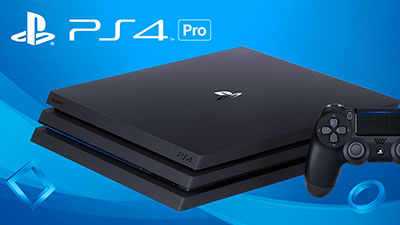
The other area to consider here is console
HDR gaming. Thankfully that part of the gaming market is a bit more mature, and
it's far simpler to achieve HDR thanks to the enclosed nature of the system - no
software, graphics card or OS limitations to worry about here. If you have a
console which can output HDR for gaming such as the PS4, PS4 Pro or X Box One S
then the Dell UP2718Q will support those over the HDMI 2.0a connection. The
screen conforms to true HDR specs as we've already mentioned (and will
discuss
more later), and will support 3840 x 2160 Ultra HD resolution and offer a wide
colour gamut for boosted colours as well. Given the consoles are limited to 60Hz
refresh rate, and you cannot use features like FreeSync/G-sync or ULMB with them
there is less of a gap between the UP2718Q performance and the likely
performance of the gaming HDR displays we mentioned before. Yes, those will
probably have faster response times, a better controlled overdrive impulse, and
probably a lower lag
but the performance of the UP2718Q is still likely to be close behind at this
60Hz console gaming limit. It is also likely to be on par or better than
many LCD TV's out there in this regard. It will of course be a much smaller
screen size than a HDR TV is likely to be, but the point here is that it can
probably handle some console HDR gaming pretty effectively if you want to. It's
not the intended market for this screen, but it's still a good possibility.

Display Comparisons
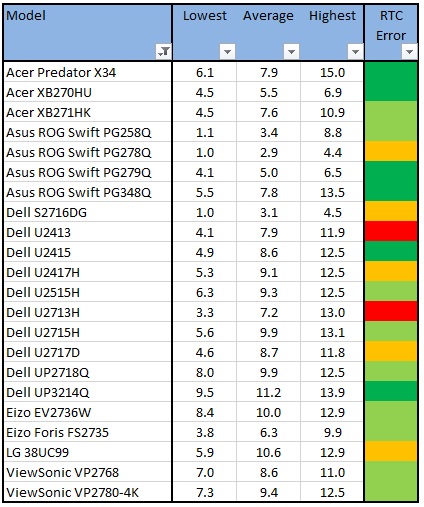
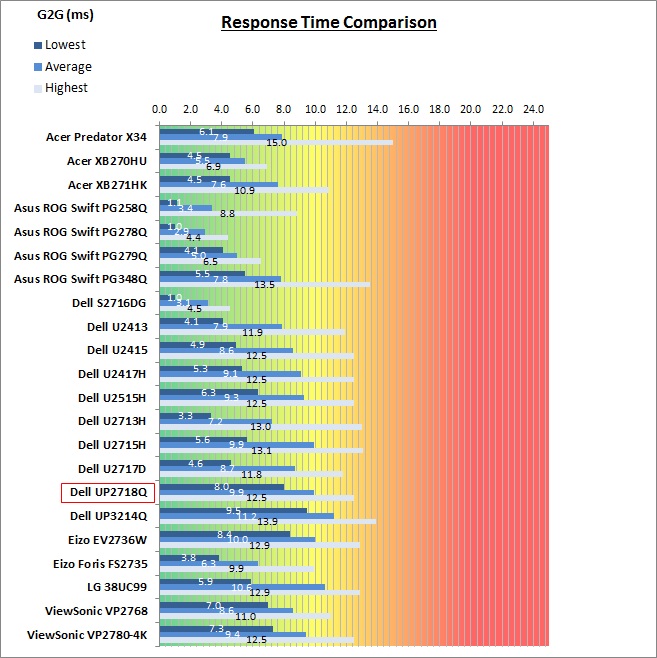
The above comparison table and graph shows you the
lowest, average and highest G2G response time measurement for each screen we
have tested with our oscilloscope system. There is also a colour coded mark next
to each screen in the table to indicate the RTC overshoot error, as the response
time figure alone doesn't tell the whole story.
As a reminder, these measurements were in the
optimal 'fast' Response Time overdrive mode. With an average of 9.9ms G2G it
fell a little behind the faster 60Hz IPS models out there (where overshoot is
low). Models like the
Dell U2415 and
ViewSonic VP2768 reach down to 8.6ms for instance, although to be fair the
UP2718Q was not exactly miles behind. It was the same as the Dell U2715H for
instance which is a well-established all round generalist screen. The high refresh rate IPS
models like the
Asus ROG Swift PG279Q (5.0ms G2G) and
MG279Q (6.5ms G2G) for
instance had performed better, and TN Film models like the
Asus ROG Swift PG278Q
(2.9ms G2G) could of course reach faster speeds and are specifically designed
for gaming audiences.

Additional Gaming Features
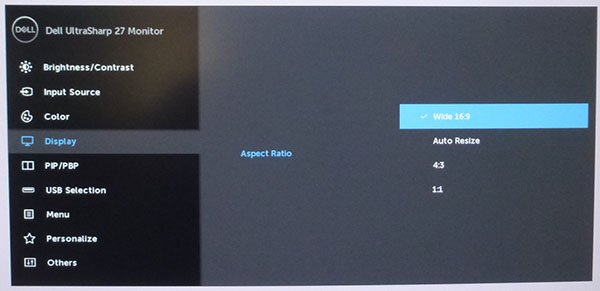
Aspect Ratio Control -
the screen offers 4 options for
aspect ratio control, available through the OSD menu in the 'display' section as shown. There
are options for wide 16:9, auto resize, 4:3 and 1:1 pixel mapping. This should suit
most people's needs, and the auto resize option is handy to maintain the source
aspect ratio but scale up as large as possible.
Preset Modes -
There is a game preset mode available in
the OSD menu as well which might be handy to set up for your particular gaming
needs.

Lag
We have written an in depth article about
input lag and the various measurement techniques which are used to evaluate
this aspect of a display. It's important to first of all understand the
different methods available and also what this lag means to you as an end-user.
Input Lag vs. Display Lag vs. Signal
Processing
To avoid confusion with different terminology we
will refer to this section of our reviews as just "lag" from now on, as there
are a few different aspects to consider, and different interpretations of the
term "input lag". We will consider the following points here as much as
possible. The overall "display lag" is the first, that being the delay between
the image being shown on the TFT display and that being shown on a CRT. This is
what many people will know as input lag and originally was the measure made to
explain why the image is a little behind when using a CRT. The older stopwatch
based methods were the common way to measure this in the past, but through
advanced studies have been shown to be quite inaccurate. As a result, more
advanced tools like SMTT provide a method to measure that delay between a TFT
and CRT while removing the inaccuracies of older stopwatch methods.
In reality that lag / delay is caused by a
combination of two things - the signal processing delay caused by the TFT
electronics / scaler, and the response time of the pixels themselves. Most
"input lag" measurements over the years have always been based on the overall
display lag (signal processing + response time) and indeed the SMTT tool is
based on this visual difference between a CRT and TFT and so measures the
overall display lag. In practice the signal processing is the element which
gives the feel of lag to the user, and the response time of course can
impact blurring, and overall image quality in moving scenes. As people become
more aware of lag as a possible issue, we are of course keen to try and
understand the split between the two as much as possible to give a complete
picture.
The signal processing element within that is quite
hard to identify without extremely high end equipment and very complicated
methods. In fact the studies by Thomas Thiemann which really kicked this whole
thing off were based on equipment worth >100,1000 Euro, requiring extremely high
bandwidths and very complicated methods to trigger the correct behaviour and
accurately measure the signal processing on its own. Other techniques which are
being used since are not conducted by Thomas (he is a freelance writer) or based
on this equipment or technique, and may also be subject to other errors or
inaccuracies based on our conversations with him since. It's very hard as a
result to produce a technique which will measure just the signal processing on
its own unfortunately. Many measurement techniques are also not explained and so
it is important to try and get a picture from various sources if possible to
make an informed judgement about a display overall.
For our tests we will continue to use the SMTT
tool to measure the overall "display lag". From there we can use our
oscilloscope system to measure the response time across a wide range of grey to
grey (G2G) transitions as recorded in our
response time
tests. Since SMTT will not include the full response time within its
measurements, after speaking with Thomas further about the situation we will
subtract half of the average G2G response time from the total display lag. This should allow us to give a good estimation of
how much of the overall lag is attributable to the signal processing element on
its own.
Lag Classification
To help in this section we will also introduce a broader classification system
for these results to help categorise each screen as one of the following levels:
-
Class 1)
Less than 16ms / 1 frame lag at 60Hz - should be fine for gamers, even at high levels
-
Class
2)
A lag of 16 -
32ms / One to two frames at 60Hz - moderate lag but should be fine for many gamers.
Caution advised for serious gaming
-
Class
3)
A lag of more
than 32ms / more than 2 frames at 60Hz - Some noticeable lag in daily usage, not
suitable for high end gaming
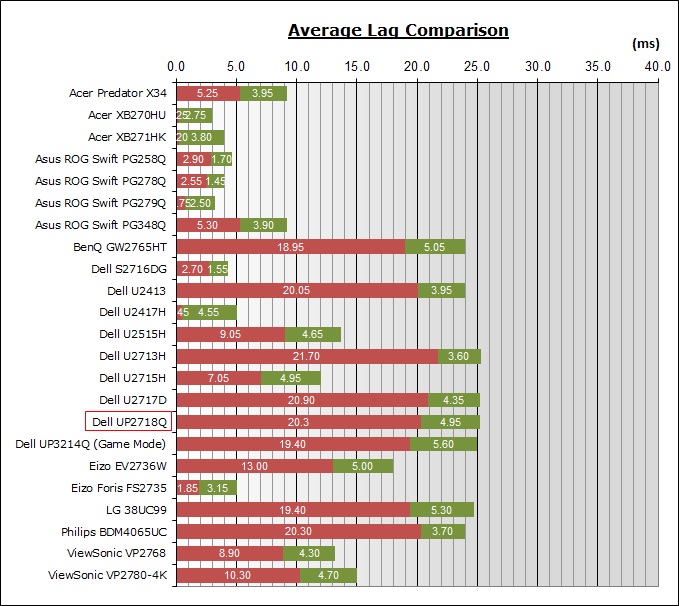
For the full reviews of the models compared here and the dates they were written
(and when screens were approximately released to the market), please see our
full
reviews index.
|
(Measurements in ms) |
|
|
Total Display Lag (SMTT
2) |
25.25 |
|
Pixel Response Time
Element |
4.95 |
|
Estimated Signal
Processing Lag |
20.30 |
|
Lag Classification |
2 |
|

Class
2 |
We have provided a comparison above against other
models we have tested to give an indication between screens. The screens
tested are split into two measurements which are
based on our overall display lag tests (using SMTT) and half the average G2G
response time, as measured by the oscilloscope. The response time is split from
the overall display lag and shown on the graph as the green bar. From there, the
signal processing (red bar) can be provided as a good estimation.
The UP2718Q showed a total lag of 25.25ms.
Taking in to account the pixel response time element at 4.95ms, we can estimate
a 20.30ms signal processing lag on this screen. It is on par with other wide
gamut screens from Dell including the U2413, U2713H and UP3214Q models for
instance. This is slightly over 1 frame of
lag. It might be a problem for very fast FPS type PC games, but for more casual
gaming and other genres it should still be fine. It is likely to be better than
many (most?) TV sets as well keep in mind for any console gaming needs you might
have.

Movies and Video

The following summarises the screens performance
in video applications:
-
27"
screen size makes it a reasonable option for an all-in-one multimedia screen,
much smaller than LCD TV's and many larger format desktop monitors which are
now emerging.
-
16:9
aspect ratio is more well suited to videos than a 16:10 format screen, leaving
smaller borders on DVD's and wide screen content at the top and bottom.
-
3840 x 2160 Ultra HD resolution can support full 1080 HD resolution content
and Ultra HD content as well.
-
Digital interfaces support HDCP for any encrypted and protected content
-
Good range of connectivity options provided
with DisplayPort 1.4, Mini DisplayPort 1.4 and 2x HDMI 2.0a offered.
-
Cables provided in the box
for DisplayPort to
Mini DP and HDMI.
-
Light
AG coating providing clean and clear images, without the
unwanted reflections of a glossy solution.
-
Wide brightness range adjustment possible from the display, including a
maximum luminance of ~349
cd/m2 and a decent minimum
luminance of 31 cd/m2. This should afford you good control for different
lighting conditions. Contrast ratio remains stable across that adjustment
range as well and is good for an IPS-type panel. Brightness regulation is
controlled without the need for PWM and so is flicker free for all brightness
settings.
-
Black
depth and contrast ratio are good for an IPS-type panel at 980:1 after
(software profiling) calibration. Detail in darker scenes should not be lost as a result.
-
There
is a specific 'movie' preset mode available for movies or video if you want
but it is cooler than our calibrated custom mode. May be useful to some though
and you can always alter it to your liking.
-
Good
enough pixel responsiveness which should still be able to handle fast moving scenes
in movies without issue. Stick with the 'fast' response time setting for
optimal performance.
-
Wide viewing angles thanks to IPS-type panel
technology meaning several people could view the screen at once comfortable
and from a whole host of different angles.
-
IPS glow is at a normal level meaning you might
experience some annoying white glows on darker content from an angle.
-
Very good and easy to use range of
ergonomic adjustments available from the stand, so should be easy to obtain a
comfortable position for multiple users or if you want to sit further away
from the screen for movie viewing.
-
No
real backlight leakage, and none from the edges which is
good. This type of leakage may prove an issue when watching movies where black
borders are present but it is not a problem here.
-
No integrated stereo speakers on this model but there is an audio put
connection if you want.
-
Decent
range of
hardware aspect ratio options with 16:9, auto resize, 4:3 and 1:1 pixel mapping modes available which
should be fine for most uses and external device connectivity.
-
Picture in picture (PiP) and Picture By Picture (PbP) are also available if
you want.
-
HDR support (discussed
in more detail later) for HDR movies and video if you
have a suitable input option. The screen offers a true Ultra HD Premium
approved HDR spec (meeting HDR10 standards) with a well-implemented local
dimming backlight system as well. So it will offer excellent performance on an
LCD screen for
HDR movies and video, albeit on a much smaller size than modern TV's. That
is probably easy enough to achieve with an Ultra HD Blu-ray player although
complex right now via a PC and with streaming content from YouTube, Netflix
and the likes. See the following HDR section for more info. That's no fault of
the display of course, just a reflection of the murky waters of PC HDR content
right now, but the UP2718Q will be ready for further HDR video and movies via
your PC in the future when that settles and comes with the DP 1.4 and HDMI
2.0a interfaces which are required.

HDR

HDR stands for High Dynamic Range and is a
technology just starting to make its way in to the desktop monitor market. It's
been around in the TV market for a couple of years and is used
primarily to provide a better dynamic range and contrast to the image for
multimedia, movies and games - that
being the difference between light and dark parts of an image. This improvement
to the dynamic range is usually
paired with other specific features under the banner term of "HDR" including a wider colour gamut for richer,
more vivid colours and specs like a 10-bit colour depth support and a high Ultra HD
resolution. Overall, an HDR Capable screen is designed to offer a more life-like
images, with better contrast ratios between light and dark areas and more vivid,
bright colours. You only need to go in to a high street store to observe the
difference that HDR makes on TV sets, so we would encourage you to do that if
you want to see first hand the improvements it makes to the image quality.
When you see the term HDR being used,
especially in the monitor market where it is still in its infancy, you need to
be aware that specs and performance will vary quite significantly. Our
detailed HDR article talks a lot more about the various technologies used,
including some standards which have been introduced to try and make HDR a little
less of a free-for-all. We will try and provide a brief summary of some of the
key HDR considerations and specs here in this review, while also looking at the
HDR performance of this screen in more detail.
One note before we get started is that the
UP2718Q is designed to support the HDR10 content standard, which is one of the
two
main standards in the industry today. Dolby Vision is the other key alternative
and that is not supported on this screen as it does not carry the necessary
Dolby Vision chip or certification,
but HDR10 has been more widely adopted by the gaming hardware and software
studios which has helped establish its position. This includes by Microsoft for the
X Box One S and Sony for their PS4 and PS4 Pro consoles. How this content format
war settles is likely to take some time, but the HDR10 standard seems to be the
most likely to take hold in the monitor market for the time being.
Backlight Dimming - A 384-zone Full
Array Local Dimming (FALD) backlight
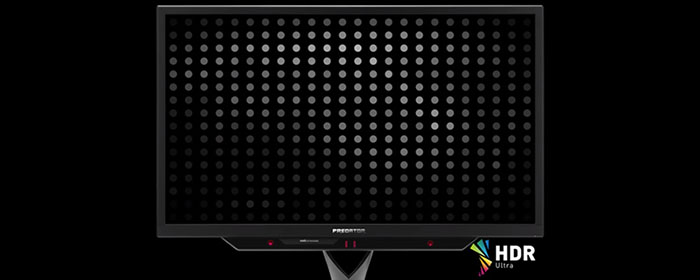
On LCD displays, the static contrast ratio is
still limited by the panel technology being used. So for a TN Film or IPS
technology panel you are still limited by a contrast ratio of around 1000 -
1200:1, and on a VA type panel you might reach up to around 3000:1 or so. The
quite well established Ultra HD Premium standards in the TV market for HDR dictate that you need a contrast ratio of
20,000:1 to conform to their specs. So how is this achieved from an LCD screen? The
answer is local dimming, operating a little bit like Dynamic Contrast Ratios (DCR)
of old. Rather than making the whole screen lighter or darker though depending
on the displayed content, local dimming attempts to dim only the dark parts of a
image, while making the light parts of the screen brighter. The result is a
localised dynamic contrast which greatly improves the picture quality and
dynamic range.
The effectiveness of this local dimming depends on how the
backlight is operated. The most basic HDR capable screens might attempt this
local dimming simply through edge-lit dimming where the panel is backlit by
LED's along the sides of the screen. While you can do some level of dimming
through the adjustment of the edge-lit LED's it gives limited control over the
zones on a screen and its very tricky to pick out small areas effectively. A far
better approach to achieving accurate and reliable local dimming is to provide a
backlight split in to hundreds of small zones, where each zone is lit by a
small set of LEDs. The higher the number of zones the better, as it gives more
finite control over the image on the screen. Dark areas can be dimmed, while
bright areas are accentuated and made brighter. This gives rise to the higher
active contrast ratio of 20,000:1 or more in the HDR spec requirements but done
in an optimal way.
On the Dell UP2718Q the panel is paired with
a 384-zone LED backlight which offers a much better control over local dimming
zones than an edge-lit option. The above image is taken from the forthcoming Acer Predator X27 display,
but that too has a 384-zone FALD backlight unit so gives a good idea of how the
panel is lit here on the Dell. Many HDR displays in the market will go for
the simpler, and cheaper edge lit dimming where larger areas of the screen must
be dimmed at once, and so the fact this model has a FALD backlight is what helps
to separate it from the others and provide more optimal HDR experience on an LCD
screen. This is
why the screen has a thicker profile and ultimately a higher retail price as
well.
You still need to keep in mind that the
screen is not being individually lit at a pixel level, and so there is still
some impact in varying the brightness of different zones, even when there are
quite a lot of small zones like here on the UP2718Q. Depending on the content
shown on the screen, you may seem some "blooming", where the bright areas have a
halo or glow around them as zones bleed over in to one another. The smaller the
bright point on the screen, the more tricky it is to correctly light it in an
HDR environment without this blooming and haloing occurring. We are still trying
to define some specific HDR tests as this is still quite a tricky area to
measure in our reviews at the moment. For now, we did have a look at Unchartered
4 on the PS4 which is a title that supports HDR. It seems that (oddly) the FALD
backlight only operates when the screen it in the 'game' or 'movie' preset
modes, which is also mentioned in the user manual. We tried both the 'normal'
and 'vivid' settings for HDR in the OSD menu, and once HDR content is detected
you get a small HDR logo appearing in the OSD menu in the top right. You also
cannot change preset mode or brightness control without first disabling the HDR
option itself so you can tell if the screen is operating in HDR mode with the
local dimming active quite easily.
We found some somewhat mixed results with the
HDR option though from the PS4 console. In the 'vivid' HDR mode there was
excessive blooming, to the point where it looked really bad. You got massive
bright blooms around bright areas, for instance in the loading screen where you
have a small spinning coin on a black background, and a small white progress %
shown. Those really highlighted the excessive blooming and bright halos. It
looks almost like really bad IPS glow or backlight bleed, but it was a result of
the local dimming backlight. It was not as obvious in normal gaming where you
have far more varied content, but the vivid mode seemed to produce too much of
this glow. We did find the 'normal' HDR mode much better though thankfully, and
the blooming was only slight on the aforementioned loading screen. Again in
actual gaming you couldn't really detect any major problems. This mode did seem
to be darker overall though, so perhaps there is some limitation of the peak
luminance range going on here. The user manual doesn't mention anything, but
there is a marked difference in how bright the bright areas appear between vivid
and normal. Although as we said, the vivid mode then results in a massive amount
of blooming. We have heard some reports that there is some noticeable lag from
the FALD as well, where it seems to take a noticeable amount of time to change a
zone on the backlight as content changes. E.g. a bright object moving across a
dark background will show a lag to the dimming zones and therefore a bloom trail
behind it. We will try to produce some further tests and update this part of the
review if we can and provide some further thoughts (updated tests in a moment
below).
You've got to keep in mind that this 384-zone
dimming is still better than edge-lit options, and in the absence of any real
OLED options in the desktop monitor market it it likely to be as good as we can
hope for right now. In actual dynamic content the blooming and lag of the FALD
is likely to be far less noticeable, and you can probably enjoy the HDR content
as it was intended to be seen. In some circumstances though you may see some
issues with the dimming zones which is probably going to be difficult to
eliminate unless manufacturers really increase the number of zones a lot
further. Maybe the speed of the dimming and changes can be improved, to avoid
any lag or bloom trails a bit more, but it's always going to be a challenge
because of the way the backlight is structured and dimmed.
Ultra HD Premium Standard Conformity
|
Ultra HD
Premium Spec Guidelines
|
Yes/no
|
Quoted
Display Spec
|
|
At least Ultra HD
Resolution 3840 x 2160 |
 |
Ultra HD 3840 x 2160 |
|
10-bit colour depth
processing |
 |
10-bit |
|
DCI-P3 colour space
coverage |
 |
97.7% DCI-P3 quoted |
|
Suitable HDR connectivity |
 |
HDMI 2.0a and DisplayPort
1.4 |
|
at least 1000 cd/m2 peak luminance |
 |
1000 cd/m2 |
|
at least 20,000:1 contrast ratio |
 |
20,000:1 |
|
|
|
Backlight dimming system
(not defined in Ultra HD Premium requirements) |
384-zone Full Array Local
Dimming (FALD) |
The
UP2718Q is the first desktop monitor to carry the
Ultra HD Premium
certification, conforming to their standards as listed above. It can be
considered therefore as a "true HDR" screen. The first obvious spec which the
screen conforms to is the 3840 x 2160 Ultra HD resolution requirement. That
allows for full native support of Ultra HD content, including from Ultra HD Blu-ray
players and modern games consoles. On a screen this size (27") it is a little
arguable whether the extra resolution is necessary. Some people may not see much
obvious difference in sharpness and image quality compared with a native 1440p
screen, especially so if you are viewing the screen from a reasonable distance
for movies or games. Nevertheless, it is included here anyway.
10-bit colour depth support is provided from the panel, again conforming to the
defined spec. From a PC you will need the relevant 10-bit workflow and graphics
card to work with 10-bit content, but from other output devices the 10-bit
support is there and ready to use - helping with colour range and gradation and
supporting the extended colour space.
Speaking of colour space, the wide gamut GB-r-LED backlight of the UP2718Q
allows for a high 97.7% coverage of the DCI-P3 reference space according to the
Dell spec, which is that defined under the Ultra HD Premium standard. We
measured independently the gamut coverage using our i1 Pro 2 spectrophotometer
and the ChromaPure 3 software. In the standard preset mode with the full
backlight native gamut being used, we measured 108.1% DCI-P3 coverage (equating
to 146.6% sRGB and 77.5% Rec.2020). In the specific DCI-P3 preset mode
which was designed to restrict the gamut within the DCI-P3 reference more
closely, we measured coverage of 94.2% (equating to 127.9% sRGB and 67.6%
Rec.2020). Still a very respectable coverage of this reference space, and
certainly the wide gamut helps to provide vivid and bright colours in HDR
content and multimedia.
Connectivity wise the UP2718Q provides two different HDR compatible interface
options. DisplayPort 1.4 for very modern and future graphics cards will support
HDR from a PC - as long as you line up all the necessary components and software
to achieve it. HDMI 2.0a will then also support HDR including from external
games consoles and Blu-ray players.
The
peak brightness of the display in HDR mode is rated at 1000 cd/m2 which is about
3 times as high as most displays in the market (when comparing their maximum
brightness spec). This doesn't mean that the whole screen suddenly operates at
1000 cd/m2 which would be blindingly bright. The UP2718Q has a normal
maximum brightness spec of 400 cd/m2, but in HDR it can
reach a 'peak brightness' of 1000 cd/m2. This is the brightness achieved where
the lighter areas of the screen are increased during HDR content, producing a better active
contrast ratio. We are exploring some further HDR test capabilities at the
moment so may come back to update this section of the review a little further if
we have chance, and still have access to the screen.
Using HDR
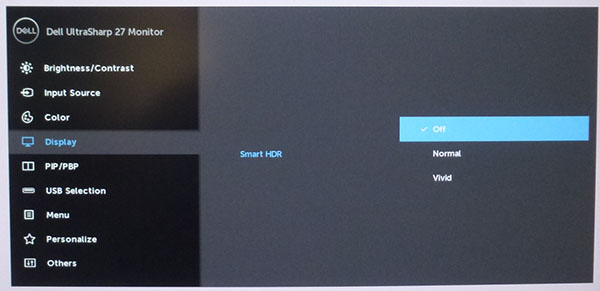
The
HDR feature is accessible via the OSD menu in the 'display' section. By default
it is off but there are options for normal and vivid available. According to the
user manual the normal mode
maps to the DCI-P3 colour space while Vivid maps to Rec.2020, or at least as
much of it as the backlight can cover. This is likely to be similar to the
DCI-P3 emulation preset vs the normal native gamut 'standard' preset. You seem
to need to be in the movie or game preset modes for the local dimming backlight
to operate, which begs the question how you are supposedly achieving any HDR
benefits in the other modes without the FALD in operation? It seems that there
is also a difference between how the local dimming backlight operates in the two
HDR settings for vivid and normal, as we talked about a bit earlier. Vivid seems
to lead to very high levels of blooming and bleeding from bright areas which in
our opinion is unacceptable. It is much better in the normal mode thankfully.
We should touch on the complexities of
using HDR at this stage though, especially from a PC. It's actually quite
complicated to achieve an HDR output at the moment from a PC and something you
should be aware of before jumping straight in to a modern HDR screen.
You
will need to ensure you have a compatible Operating System for a start. The
latest Windows 10 versions for instance will support HDR, but if you turn on the
HDR option from the OSD menu you will see some odd behaviour. The image looks dull
and washed out as a result of the OS forcing HDR on for everything. HDR content
should work fine (if you can achieve it - more in a moment!) and provide a
lovely experience with the high dynamic range and rich colours as intended.
However normal every day use looks wrong with the HDR option turned on. Windows
imposes a brightness limit of 100 cd/m2 on the screen so that bright
content like a Word Document or Excel file doesn't blind you with the full 1000
cd/m2 capability of the backlight. That has a direct impact on how
the eye perceives the colours, reducing how vivid and rich they would normally
look. It also attempts to map the common sRGB content to the wider gamut colour
space of the screen causing some further issues. Sadly Windows isn't capable of
turning HDR on/off when it detects HDR content, so for now it's probably a case
of needing to toggle the option in the screen menu when you want to view HDR
content. Perhaps as HDR settles a bit more we will have better OS support
emerge.
That is a little fiddly in itself, but a current OS software limitation. The
other complexity of HDR content from a PC is graphics card support. The latest
NVIDIA and AMD cards will support HDR output and even offer the appropriate
DisplayPort 1.4 (or HDMI) outputs you need. This will require you to purchase a
top end graphics card if you want the full HDR experience, and there are some
added complexities around streaming video content and protection which you might
want to read up on further. There are graphics cards now available to provide
that HDR option from a PC, but they are going to be expensive right now.
Finally, content support is another complex consideration from a PC. HDR movies
and video including those offered by streaming services like Netflix, Amazon
Prime and YouTube currently won't work properly from a PC due to complicated
protection issues. They are
designed to offer HDR content via their relevant apps direct from an HDR TV
where the self-contained nature of the hardware makes this easier. So
a lot of the HDR content provided by these streaming services is difficult or
impossible to view from a PC at the moment. Plugging
in an external Ultra HD Blu-ray player with HDR support is thankfully simpler,
and should work nicely from this screen thanks to its true HDR spec. You are removing all the complexities
of software and hardware there, as the HDR feature is part of the overall device
and solution.
PC
HDR gaming is a little simpler, if you can find a title which supports HDR
properly! There are not many HDR PC games around yet, and even those that
support HDR in the console market will not always have a PC HDR equivalent.
Obviously more will come in time, but it's a little limited at the time of the
UP2718Q launch. We have talked a bit more about the gaming considerations,
including the simpler and easier console gaming options in
an earlier part
of the review if you want to read more.
None of this is the fault of the display, and we should make it clear that the
UP2718Q is certainly capable in itself of HDR content, and will be HDR-ready for
you in the future. You just need to be aware of the difficulties in actually
getting HDR working from the PC side of things right now and understand that it
might limit your uptake of HDR material as a consumer right now. The TV market
is a simpler space for HDR right now, but although HDR is now emerging in the
monitor market, the driving PC content side of things still needs time to catch
up and settle.
HDR Testing Updates (updated 6 December 2017)
We
have gone back and revisited the UP2718Q to conduct some further HDR tests now
that we've had chance to define some test systems. We would like to thank
OneAV.co.uk for the loan of a
Murideo
Fresco SIX-G test tool which allowed us to conduct some further analysis of
the display. This was combined with some new tests we have established
ourselves, used recently on the
Samsung C32HG70 but now re-tested here on the UP2718Q as well.
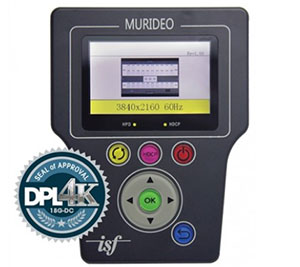
HDR
Luminance and Peak Brightness
In
a new set of tests we measured the luminance and contrast performance of the
screen in HDR mode in a variety of scenarios. A white box is displayed on the
screen which covers 1% of the overall screen size initially. This is designed
to show at several target luminance levels, starting at 100 and then changing to
400 and 1000 cd/m2 (and beyond if needed). We measure the actual
luminance of that white box to see how close to the target luminance the screen
actually performs at each step. When the screen reaches the maximum peak
luminance possible, we also measure the black depth of the screen at a point
furthest away from the white area. This can then allow us to calculate the HDR
active contrast ratio, the difference between the bright white area on screen, and the
dark black areas elsewhere.
This 1% white screen coverage is designed to give a rough representation of how
a small highlight area in HDR content might appear and work in normal
multimedia. The white box then increases to a larger size, covering 4, 9, 25, 49 and
finally 100% of the screen area. This represents different sized areas of bright
content in HDR multimedia. Again those progressively larger boxes are shown at
the different luminance targets, and we measure the actual screen luminance
achieved for each.
Smart HDR Mode = Normal
|
White window size |
100 cd/m2 target |
400 cd/m2 target |
1000 cd/m2 target |
2000 cd/m2 target |
4000 cd/m2 target |
|
Peak luminance
(cd/m2) |
Min black depth
(cd/m2) |
HDR contrast (x:1) |
|
1% |
37 |
100 |
252 |
439 |
440 |
|
440 |
<0.02 |
>22,000 |
|
4% |
61 |
164 |
419 |
729 |
730 |
|
730 |
<0.02 |
>36,500 |
|
9% |
77 |
207 |
527 |
915 |
917 |
|
917 |
<0.02 |
>45,850 |
|
25% |
94 |
253 |
642 |
1115 |
1117 |
|
1117 |
0.04 |
27,925 |
|
49% |
101 |
249 |
477 |
696 |
697 |
|
697 |
0.09 |
7,744 |
|
100% |
72 |
142 |
270 |
393 |
394 |
|
394 |
n/a |
n/a |
With
the screen set in the 'normal' HDR mode you can see that for some reason the
display had a difficult time meeting the desired luminance level for the content
being displayed in most cases. For instance at the small 1% screen coverage, a
white highlight designed to show at 400 cd/m2 only reached 100 cd/m2.
And at 1000 cd/m2 target, the supposed maximum luminance of the
screen, it only reached 252 cd/m2. You had to attempt to show content
that was designed to display at 4000 cd/m2 (theoretically beyond the
capability of the screen) in order to encourage the screen to reach its peak
luminance level. Even then, with a small 1% white coverage the peak luminance
only reached 440 cd/m2.
It
was a similar situation across most measurements really which was a little odd.
We had seen a more reliable performance from the lower-grade (HDR wise) Samsung
C32HG70 which had more easily achieved the target luminance in many cases,
certainly for the smaller white area tests. So the UP2718Q seemed to struggle
with reaching the desired peak luminance of the content in this 'normal' mode.
You can see that the screen is capable of producing a peak luminance of 1115
cd/m2 (actually a little above the specified 1000 cd/m2),
but that was only achieved in the scenario with a quite large 25% white screen
coverage, and when actually the content was being mastered at 2000 cd/m2.
At 25% coverage, the actual 1000 cd/m2 content only reached 642 cd/m2.
On a
more positive note, the screen was at least capable of producing some very high
HDR contrast ratios, up over 45,850:1 in some cases. The FALD was
capable of dimming dark areas of the screen very low, at the same time as
increasing the luminance of the light areas. It just didn't seem to be able to
brighten those light areas enough to reach the desired brightness of the content.
The result of all this in practice is that you get very nice contrast between
bright and dark areas of an image which is very nice, but the bright highlights
are not as bright as they are supposed to be.
Smart HDR Mode = Vivid
|
White window size |
100 cd/m2 target |
400 cd/m2 target |
1000 cd/m2 target |
2000 cd/m2 target |
4000 cd/m2 target |
|
Peak luminance
(cd/m2) |
Min black depth
(cd/m2) |
HDR contrast (x:1) |
|
1% |
184 |
486 |
827 |
880 |
880 |
|
880 |
<0.02 |
>44,000 |
|
4% |
237 |
597 |
1010 |
1077 |
1077 |
|
1077 |
<0.02 |
>53,850 |
|
9% |
272 |
673 |
1122 |
1194 |
1194 |
|
1194 |
0.03 |
39,800 |
|
25% |
265 |
587 |
936 |
996 |
996 |
|
996 |
0.04 |
24,900 |
|
49% |
152 |
346 |
541 |
575 |
575 |
|
575 |
0.14 |
4,107 |
|
100% |
107 |
251 |
410 |
435 |
435 |
|
435 |
n/a |
n/a |
We
switched up to the 'Vivid' HDR mode as well which produced somewhat of the
opposite issue. Now, the bright points were mostly being produced too bright,
beyond their intended luminance level. For instance a 4% white window designed
to show at 100 cd/m2 was now being displayed at 237 cd/m2.
A 9% white window designed to show at 400 cd/m2 was now displayed at
673 cd/m2. For content designed at 1000 cd/m2, this was
now achieved for smaller white areas of 1, 4 and 9% as desired, although this is
probably only because the backlight is limited to around 1000 cd/m2
maximum. Had it been able to achieve brighter, we expect that those targets
would have been exceeded by some way like the 100 and 400 cd/m2
levels were.
By
the time you reach a fairly large screen coverage of 25% for a bright area, you
probably don't want to be reaching the full peak luminance anyway, as although
1000 cd/m2 is fine for a small highlight, on a large screen area up
close it can be blinding. Here on the UP2718Q even a 25% white area produced a
996 cd/m2 peak luminance for some higher brightness content.
Again the HDR contrast ratio created was very high in this mode, and the FALD
backlight was certainly capable of dimming the dark areas very low, while at the
same time making the bright areas brighter. This is one of the benefits of the
384-zones, giving a decent control over small local areas. However, in practice
the fact that the target luminance was often being exceeded by quite a large
amount in this 'Vivid' mode resulted in a large amount of halo-ing and blooming
around bright areas. We had seen this before in our PS4 tests, but this
over-achievement of the desired luminance seemed to be the issue in this mode.
We wouldn't recommend using the 'Vivid' mode to be honest, it seems to be
pushing the luminance too high and just causes problems.
Additional Tests
The
Murideo Fresco Six-G is an external hand held device primarily designed to allow
simple testing of TV sets, allowing you to run a series of test patterns and
feed a number of different sources to the screen to establish support of various
things, and evaluate how the display performs. For desktop monitors connected to
a PC you can do a lot of this by other means, but it was a useful tool to check
various areas on the UP2718Q. We connected over the HDMI connection and
confirmed the following of interest:
1) Support for different resolutions/refresh rates - This confirms what
timings are supported for external devices running at common resolution/refresh
rate timings
|
Input Timing Resolution/Refresh |
Supported by UP2718Q |
|
720p, 60Hz |
 |
|
1080i, 60Hz |
 |
|
1080p, 60Hz |
 |
|
4960 x 2160 (4K), 24Hz |
 |
|
3840 x 2160 (Ultra HD), 30Hz |
 |
|
3840 x 2160 (Ultra HD), 60Hz |
 |
2)
HDCP Support - versions 1.4 and 2.2
were both supported
3)
Blooming - one test shows a white circle which moves slowly across the
screen in a pattern. You can use this test in a darkened room to observe any
blooming that might be produced quite easily. In the 'normal' mode there was a
slight halo around the moving object as zones were lit and darkened while it
moved. Unless you had an even higher number of zones down to the individual
pixel level, this cannot be eliminated entirely. The blooming around the white
moving object was not obvious in real use like your PS4 gaming tests (in the
normal HDR mode). On the Samsung C32HG70 which has only 8 dimming zones, you can
see this blooming more easily, as larger areas need to be brightened and dimmed
to try and account for the small areas of differing content. The 384-zone FALD
helped keep that blooming to a minimum here. In the 'vivid' mode the blooming
was really obvious and distracting.
4)
FALD delay - By using the same moving white circle test pattern we can
also measure how quickly the FALD backlight brightens and then dims the
backlight. We measure the change in screen luminance as the white moving circle
passes in front of our photosensor.
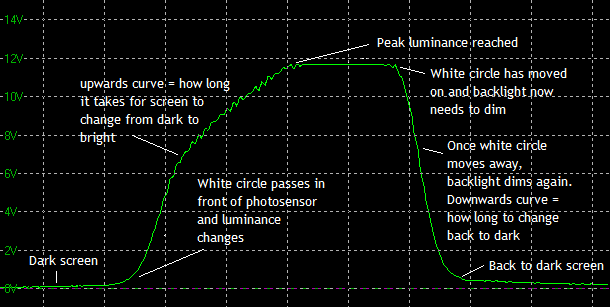
HDR mode = Normal
Horizontal scale = 320ms
Above is a measurement of the screen in the 'normal' HDR mode. We have annotated
the graph to make it easier to understand. If we consider our typical response
time measurement technique and measure with a 10% threshold from the bottom to
the top of the curve we can establish how long it takes the screen to reach the
peak luminance, and how long it takes the screen to return to darkness after the
white circle has moved on. It takes approximately 624ms (0.624 seconds) for the
FALD backlight to do its thing, and change from showing dark content to the peak
luminance output it will reach for that particular content. It then takes the
FALD backlight 200ms (0.2 seconds) to switch back to darkness after the white
circle has moved away. This delay is what contributes towards some of the
blooming that you see behind the moving object and you can feel a bit of lag as
the backlight has to keep up with the changing content.

Conclusion
In wrapping up this massive review it feels
important to remember the target market and uses for this Dell display. It is a
high-end screen aimed at colour critical work, professional users and HDR
content creators primarily. No doubt it will attract some attention from early
adopters keen to venture in to the world of HDR from a desktop monitor for
gaming and videos as well, but those are not really the intended application. We
will talk about that in a moment. The UP2718Q does offer an excellent option for
professional use, with the wide gamut backlight and massive range of presets and
colour spaces making it ideal for those wanting to work with varying content. An
Ultra HD resolution for super-sharp images, the 10-bit support colour depth and
features like hardware calibration and the very good uniformity correction
function separate it from general screens. Even if you ignore the HDR support,
the UP2718Q is an excellent option following on from other previous UltraSharp
Premium screens.
Overall it's a bit mixed when it comes to HDR
support although the screen is certainly future-proofed for high end true HDR
uses. It's just that we're not convinced the rest of the HDR journey is there
yet. This is not through any fault of Dell's or the display, but more to
do with how the current PC and monitor HDR market is right now overall. If you
are an HDR consumer and have the necessary HDR input sources figured out, then
this is one of the few choices around right now. There are some other so-called
HDR screens out there now, but most won't meet true HDR10 specs or have the
advanced backlight systems that the Dell provides so that helps distinguish this
as a high end HDR option. Just don't underestimate the
complexities in actually getting HDR to work or finding the content just yet
from a PC. The screen will set you up nicely for the future as it becomes more
readily available, but don't be fooled in to thinking there's loads of
consumption options out there right now. Where HDR is more settled at the moment
is with external devices like Ultra HD Blu-ray players and games consoles. They
should work well from the UP2718Q thankfully and make use of the true HDR
performance offered. If you are a content creator trying to develop HDR content
then the UP2718Q is an excellent choice as the
true HDR spec and well-implemented local dimming backlight system make working
with HDR content very possible.
If you appreciate this review and enjoy reading and like our work, we would welcome a
donation
to the site to help us continue to make quality and detailed reviews for you.
|
Pros |
Cons |
|
Massive range of colour
spaces and wide gamut support for colour critical and professional uses |
Not the fastest pixel
response times, some moderate lag and limited to 60Hz so not ideal for
fast PC gaming |
|
Hardware calibration and
very good uniformity correction function |
Achieving HDR from a PC
is still very difficult, but no fault of the displays |
|
HDR10 / Ultra HD Premium
HDR spec and 384-zone FALD backlight |
Hardware calibration is
very slow, thankfully you won't have to repeat too regularly |
|
Check Pricing and Buy - Direct Links
|
|
Amazon
|
|
TFTCentral is a participant
in the Amazon Services LLC Associates Programme, an affiliate
advertising programme designed to provide a means for sites to earn
advertising fees by advertising and linking to Amazon.com, Amazon.co.uk,
Amazon.de, Amazon.ca and other Amazon stores worldwide. We also
participate in a similar scheme for Overclockers.co.uk. |
|

|
TFT Central Awards Explained
We have two award
classifications as part of our reviews. There's the top 'Recommended'
award, where a monitor is excellent and highly recommended by us. There is
also an 'Approved' award for a very good screen which may not be perfect,
but is still a very good display. These awards won't be given out every
time, but look out for the logo at the bottom of the conclusion. A list of
monitors which have won our awards is available
here. |